garden folk the g Keep spired
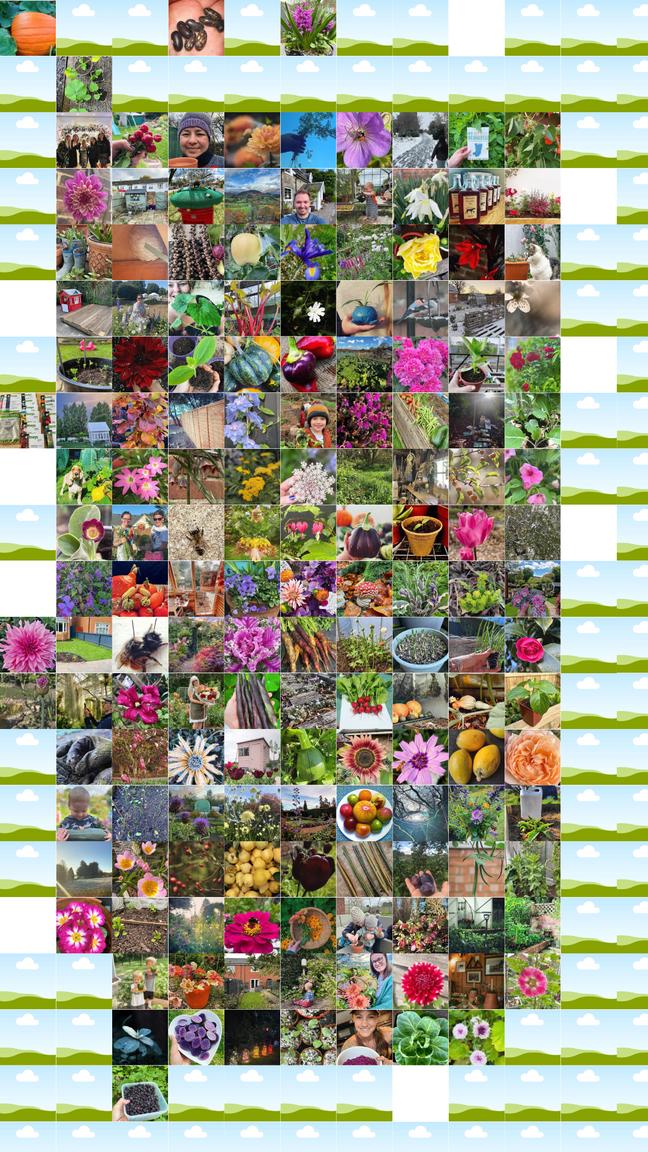
I s s u e 1 3 l M a r c h l 2 0 2 4 y

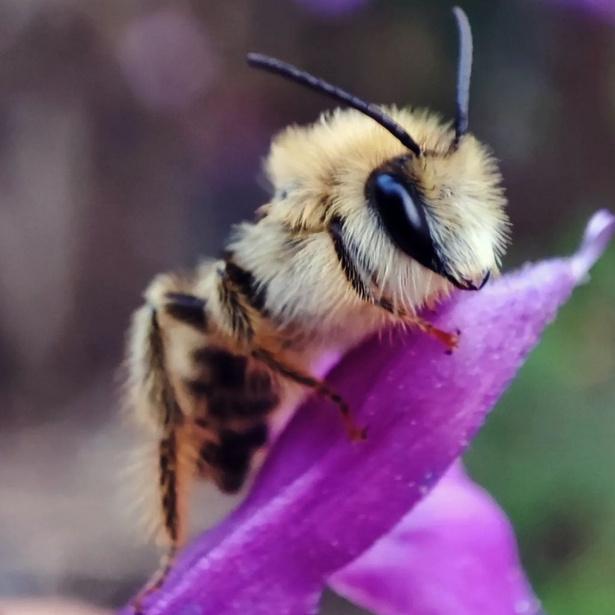
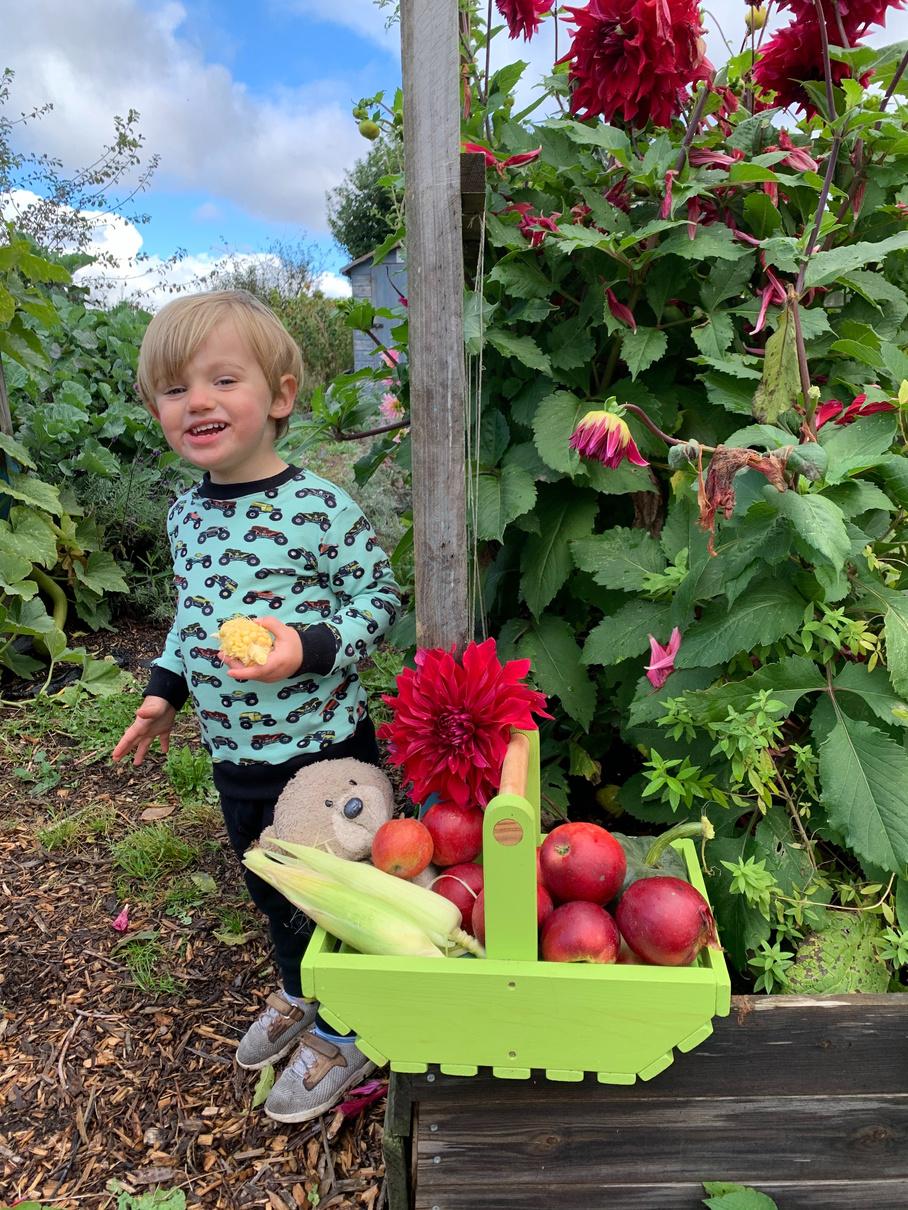

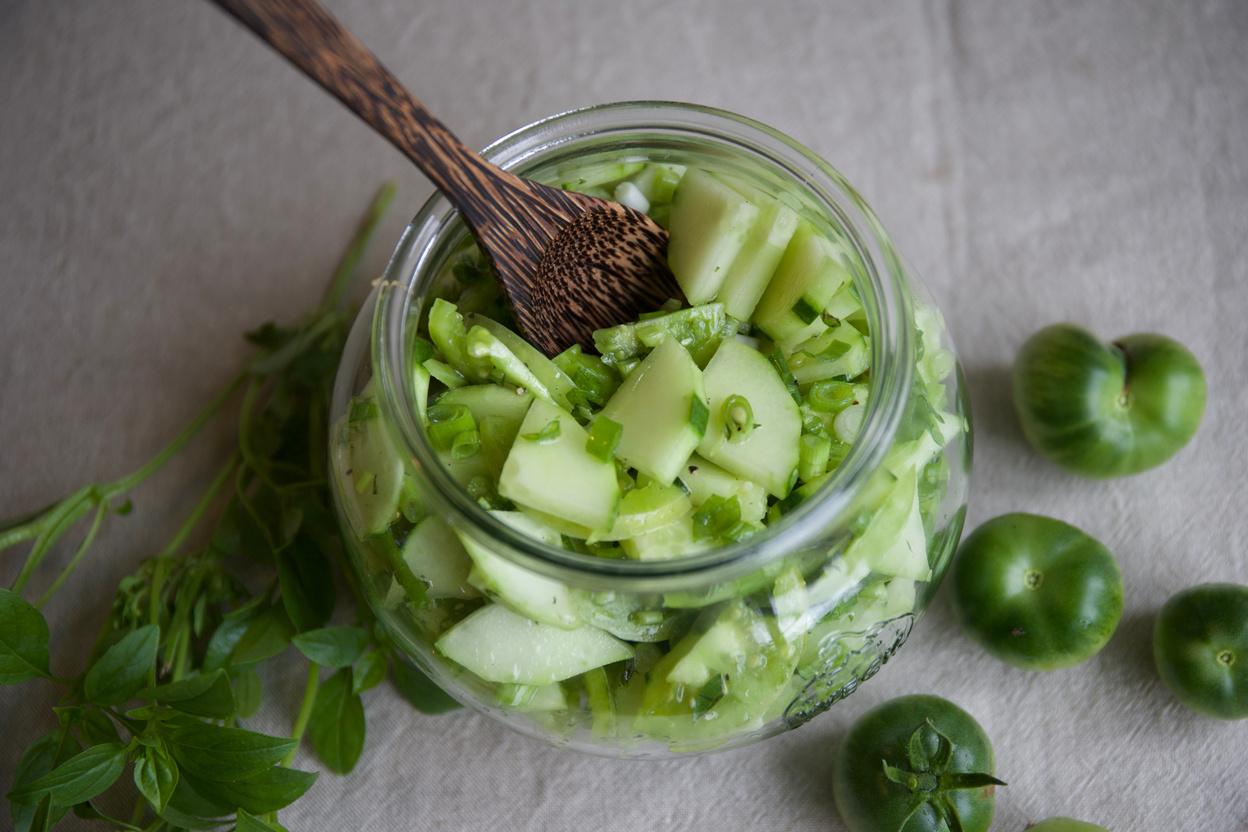
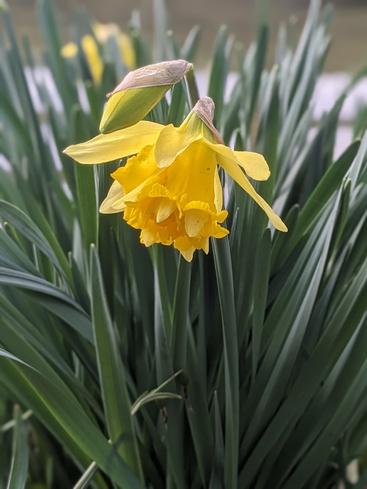
2 Managing Editor - Ally Phillimoore Senior Editor - Anjee Harrison Marketing Editor- Ellen Mary Webster Would you like to be part of a future issue? Just pop us an email info@gardenfolkmag.com 3 11 Wellbeing 3 5 For the love of gardening Healing power of garden and nature 2 Celebrating 1 year Features 8 Heritage gardening 26 Keeping it seasonal : Spring This Month 11 Young Folk 14 Garden Inspiration 12 Create a sensory garden: on a budget Garden Journeys 14 Following in my footsteps Garden Projects 15 Spring photo projects 20 Create a sweet pea teepee 24 Plot to Plate: All hail king kale Journey of plot 40A 19 Giveaway: The Creative Kitchen 31 Notebook of a flower farmer 32 Gardening in March Garden Folk Friends 33 35 26 31 8 P h o o C r e d i t : D e r e k D a l y P h o t o C r e d i : P e r m a n e n t P u b i c a t o n s P h o t o C r e d i : E m a n u e l e P a u s o n P h o t o C r e d i : C r o f 1 6 P h o o C r e d i : M e l s s a H e r r i s @gardenfolkmag

Welcome to the all new Garden Folk Mag In this March 1 year anniversary issue you’ll find garden inspo, helpful advice, gardening stories and delicious recipes from across this amazing community of Garden Folk!
This time last year Garden Folk Mag was born. The vision was to create an online magazine for the gardening community by the gardening community.
It’s been one hell of a journey! We have had so many late nights and put in hours and hours of hard work but it’s all been worth it
The team has changed and grown but the ethos has stayed the same We want to create an inclusive magazine which represents all of the gardening community and inspire more people to venture into the garden and start a new journey
As we head into a new year of the magazine we have so many ideas and plans to grow this community and welcome lots of new Garden Folk Friends. I hope lots of you will join us for our first grow along (get in touch for your free seeds!)
At the heart of the magazine are all of our amazing writers and of course the readers; we thank each and every one of you for helping to make the magazine what it is today
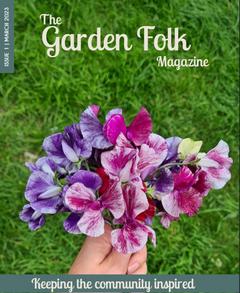


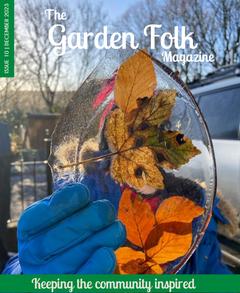
We cannot wait to share more of your stories this year and see the Garden Folk Family grow!
Ally, Managing Editor

I first became involved with Garden Folk Magazine when I wrote an article on ‘Perennial Edibles’ for the very first issue Never having written for a magazine before, I was nervous, but Ally was so encouraging, and I enjoyed the process so much, I became a regular writer. Over the summer, I did a little ‘helping out’ with a bit of editing and somehow landed myself the editor job full time! It's an absolute joy to be part of creating something so positive in the gardening world and I'm relishing the opportunities the role brings my way
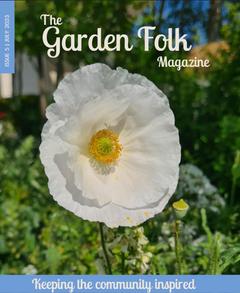
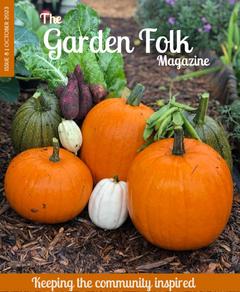




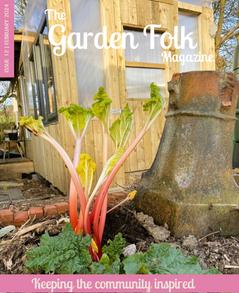
I'm so proud to be working with Ally and Ellen and of the magazine we ’ ve created with your help We are a community magazine and celebrating this incredible gardening community in such an inclusive, relevant way makes me so happy I can’t wait to see what the next year brings!
Anjee Harrison, Senior Editor
A new online gardening magazine was just what the community needed, so it’s been a joy to see it come together and so many people contributing some really fun and interesting content over the last 12 months. Behind the scenes, it’s great working with Ally and Anjee to ensure the magazine gets seen and out there each month
It’s great to see topics covered that might not be seen in other magazines and I’m really looking forward to being part of the development for the future What a first year it’s been! Well done team and the gardening community
Ellen Mary Webster, Marketing Editor
3



3 P h o o C r e d i t : S a m M a s k e l

Gardening feels an inherent part of who I am, I thrive on it, it levels me and never more so than during the past few years In my mid-forties, originally from Essex but now living in Worcestershire, I find myself experiencing a deep passion for the world of gardening I am acutely aware of how fortunate I am to now have my own green space, that in part has become my garden allotment It offers me an outlet to work through and escape anxious moments, worries and life’s stresses that capture many of us from time to time I’ve also found great comfort in #GardenGram, our supportive Instagram community It’s a great platform for learning, sharing ideas and for making like-minded friends
Growing up in a flat, I was introduced to the magic of gardening at a very young age by my grandparents in their respective gardens. It felt like stepping into an enchanting Narnia type world filled with giant rhubarb leaves and insects to find. My paternal Grandad aka ‘Fathie’ would reward my efforts with homegrown pickled cucumbers and sun warmed tomatoes outside in his garden, chubby muddy fingers and all. He grew the most exquisite scented roses, filling his front garden with bright and pastel coloured blooms, his pride and joy. My maternal Nanny, also a keen gardener who I adored spending as much time as possible with as a child, whether in her garden spotting bumblebees dancing on swathes of lavender then turning spent lavender heads into scented bags to gift to loved ones or picking juicy ripe blackberries and baking them into something delicious together
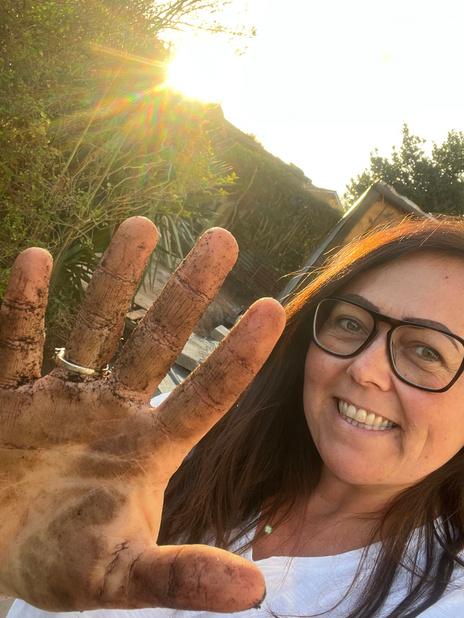
Simple pleasures and what feels like simpler times, the sentimentality of gardening grows with me as I grow older and though I no longer have my grandparents here to learn from, I treasure the feelings of freedom and familiarity only gained from being outside in nature
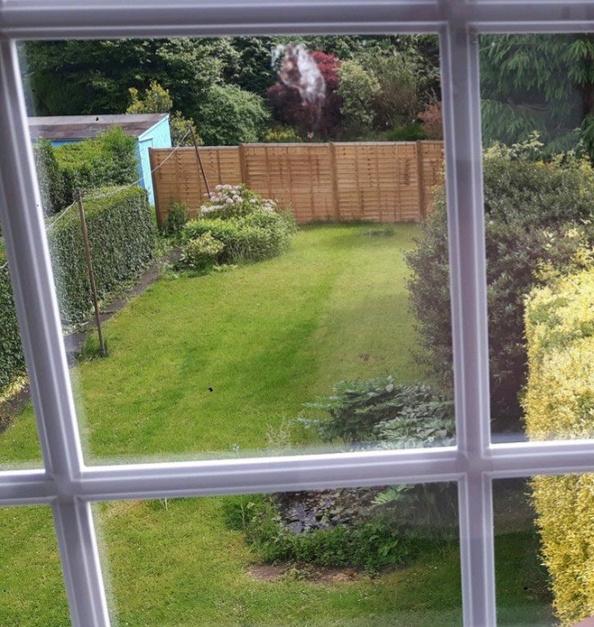
Life is, for the most part, a joy, though with the gift of ageing we also go through many experiences and sadly not all of them are positive This is where gardening has taken on something far more powerful for me than it being just my hobby When I lost my Dad suddenly 9 years ago, I yearned for a garden again, an inner calling that formed one of the main reasons why I moved to where I now live. At the same time, I was working across my two businesses and caring for my Grandad who suffered greatly with his mental health, resulting in what felt to me like a huge amount of pressure, particularly whilst in the depths of grieving myself. I’m not afraid to admit that I did not cope very well and therefore struggled with my own mental health. Roll forward, I moved into my now home with a blank canvas for a garden which was a total breath of fresh air, it ignited my hunger for gardening which in turn, I believe, has saved me from falling into a black hole on many an occasion.
I seek solace in my garden at all times of year, I cherish the changes, enjoy the wildlife that often frequent it, including a 40+ strong sparrow squad, starlings and robins I am grateful for how my garden somehow knows when I need comforting
Gardening aids us to become more present in the moment and I now enjoy practicing mindfulness Listening to the birds chirping, feeling the breeze and sunshine on my skin, smelling delicious sweet peas on the air, sowing seeds, delighting at the sight of something germinating and even learning from when things have not gone quite right (this happens often) And, being a fairly spontaneous person, for the most part relishing change, I find deep reassurance in the cyclical nature of gardening through the seasons with the added excitement of not knowing how something will turn out, always safe in the knowledge that just a few precious moments with my hands in the soil will bolster me again.
@ appy p ace ga de e Wellbeing 5
? ?
P h o t o C r e d t : S a m M a s k e l P h o o C r e d i : S a m M a s k e l
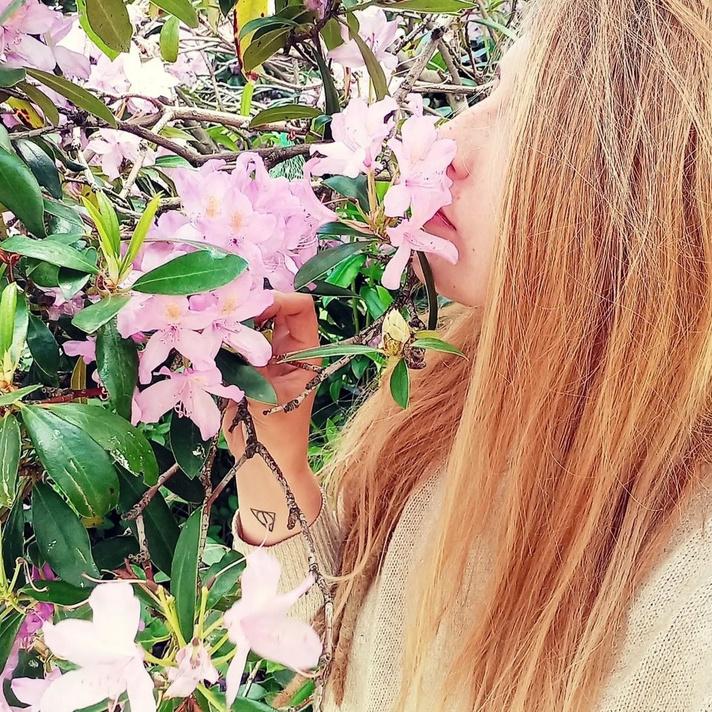

For as long as I can remember, I've struggled with stress, low self-esteem, and anxiety These struggles have been constant companions, infiltrating my mind and body They have woven themselves into persistent threads throughout my mind, making me feel overwhelmed, adrift and powerless I can feel as though I am drowned out by a million racing thoughts In those moments, relaxing and unwinding becomes very difficult and at times it can even feel impossible Stress doesn't merely take over my thoughts; it seizes control of my entire body. I find myself unable to eat, grappling with stomach pains, experiencing shakes and headaches. My body tenses up, and I resort to biting my nails compulsively, a physical manifestation of the turmoil within.
Despite perceptions, I am not the confident person people assume I am. Behind the smile, I battle with internal turmoil. This lack of confidence and tendency to overthink trace their roots back to a tumultuous childhood marked by bullying and other lingering traumas, which resulted in struggles with low self-esteem. The echoes of these past experiences often trap me in a cycle of self-doubt, where I scrutinize every aspect of my identity Even as I write down these words, a nagging voice insists that my thoughts are inconsequential and that I am making a fool of myself by writing them here However, I am determined to break free and be more open about my struggles and journey I often find it difficult to reach out to others during these moments, where stress, anxiety, and self-doubt take over A personal hurdle I am actively working to overcome Despite the difficulty, I am pushing myself to connect with others when stress and anxiety are clouding my mind and body
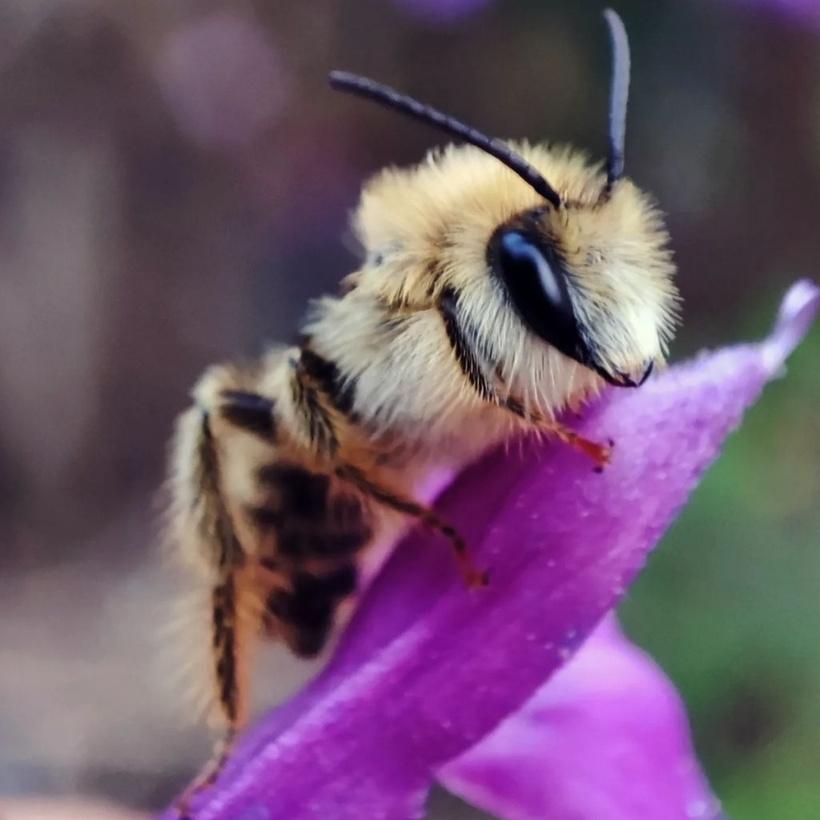
One of the things that has helped me a lot the last few years, when dealing with stress, anxiety, and self-doubt, is gardening. It has been a great stress relief to clear and calm my mind in this journey of healing I have found a solace and peace I never thought possible by just being outside in the garden, surrounded by nature's symphony the birds singing their song, the gentle buzz of bees, the rustling of leaves, the soft chirping of crickets
Digging into the earth, breathing in the fresh air, watching butterflies fluttering by and observing the unhurried pace of nature provides a reprieve, allowing me to step back, recharge, and find tranquility Nature doesn’t judge and it never rushes It takes its time to develop at its own gentle pace A tangible reminder that growth, like the sprouting seedlings, unfolds at its own unhurried pace.
6
P h o t o C r e d t : M e i s s a H e r r i s P h o t o C r e d i : M e i s s a H e r r s
By Melissa Herris @bluebellandbumblebee

It helps me to feel grounded again, connected, and to find that one little moment of peace to stop my mind from racing around Gardening has become more than a hobby and a pastime, it has become a passion that helped me more than I ever could have imagined. Just being outside in the garden has become a haven. In our garden’s embrace, stress slowly but surely becomes less overpowering, like morning dew touched by the rising sun. The garden becomes a safe space where judgment is nonexistent, and the relentless pace of the world outside slowly, but surely fades away. The garden's patience mirrors the inner peace I seek, encouraging me to slow down, embrace the present moment, and let go of the burdens that weigh on my mind In this harmonious dance with nature, I find a sense of grounding and connection
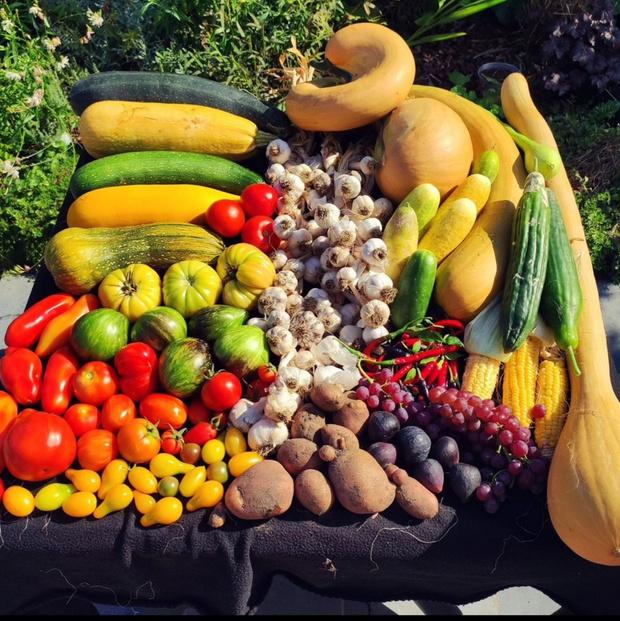
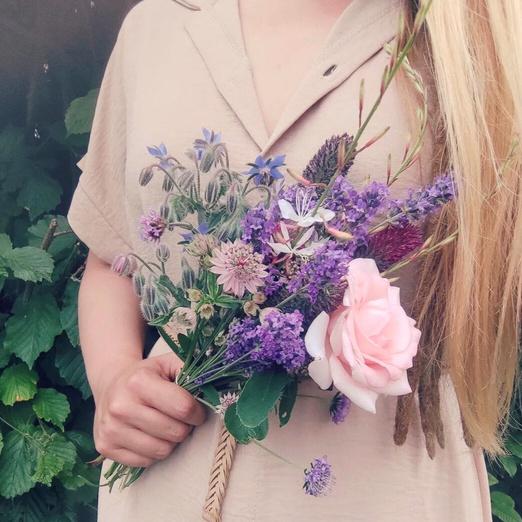
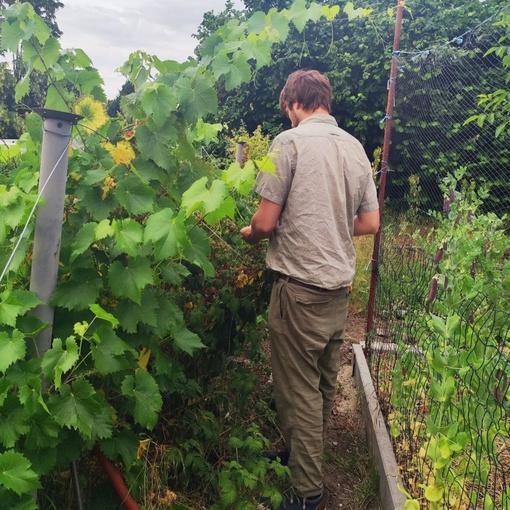
The garden becomes a sanctuary where I can find that one precious moment of peace amidst the whirlwind of my mind. As I nurture the garden, it, in turn, nurtures me The therapeutic and healing power of gardening, with each seed sown and each bloom cherished, mirrors my own growth My garden continues to nurture me; a testament to the transformative and healing power of nature
If you connect to parts of my story or if you ever need someone to talk to, please don't hesitate to reach out Remember, you are not alone in this journey and I’m here to lend a listening ear
Wellbeing 7
P h o o C r e d t : M e i s s a H e r r i s P h o t o C r e d i : M e i s s a H e r r s P h o t o C r e d i : M e i s s a H e r r s
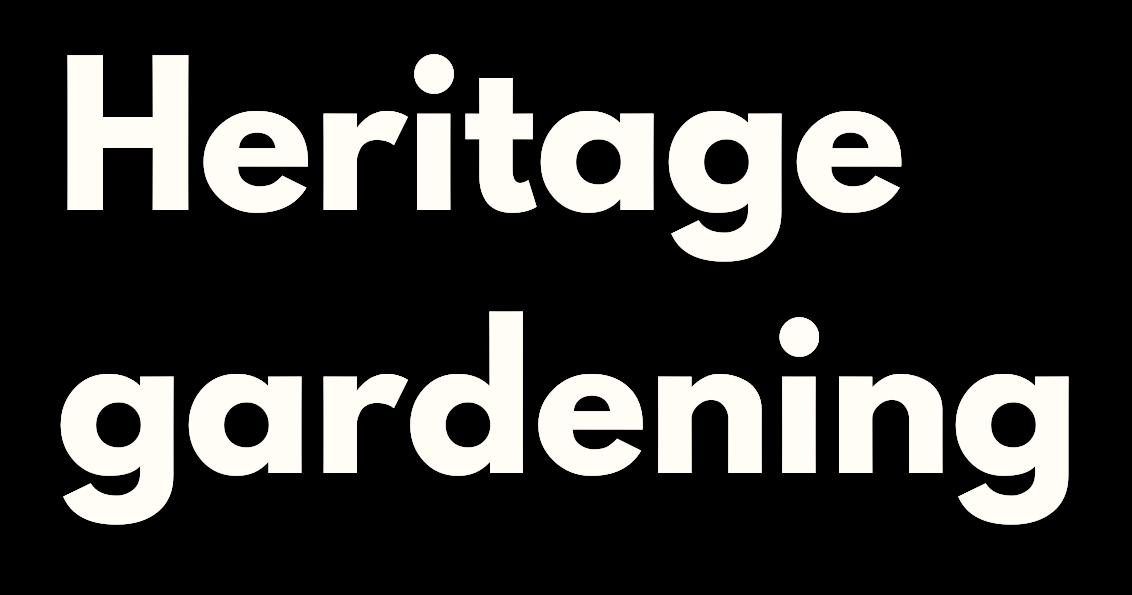

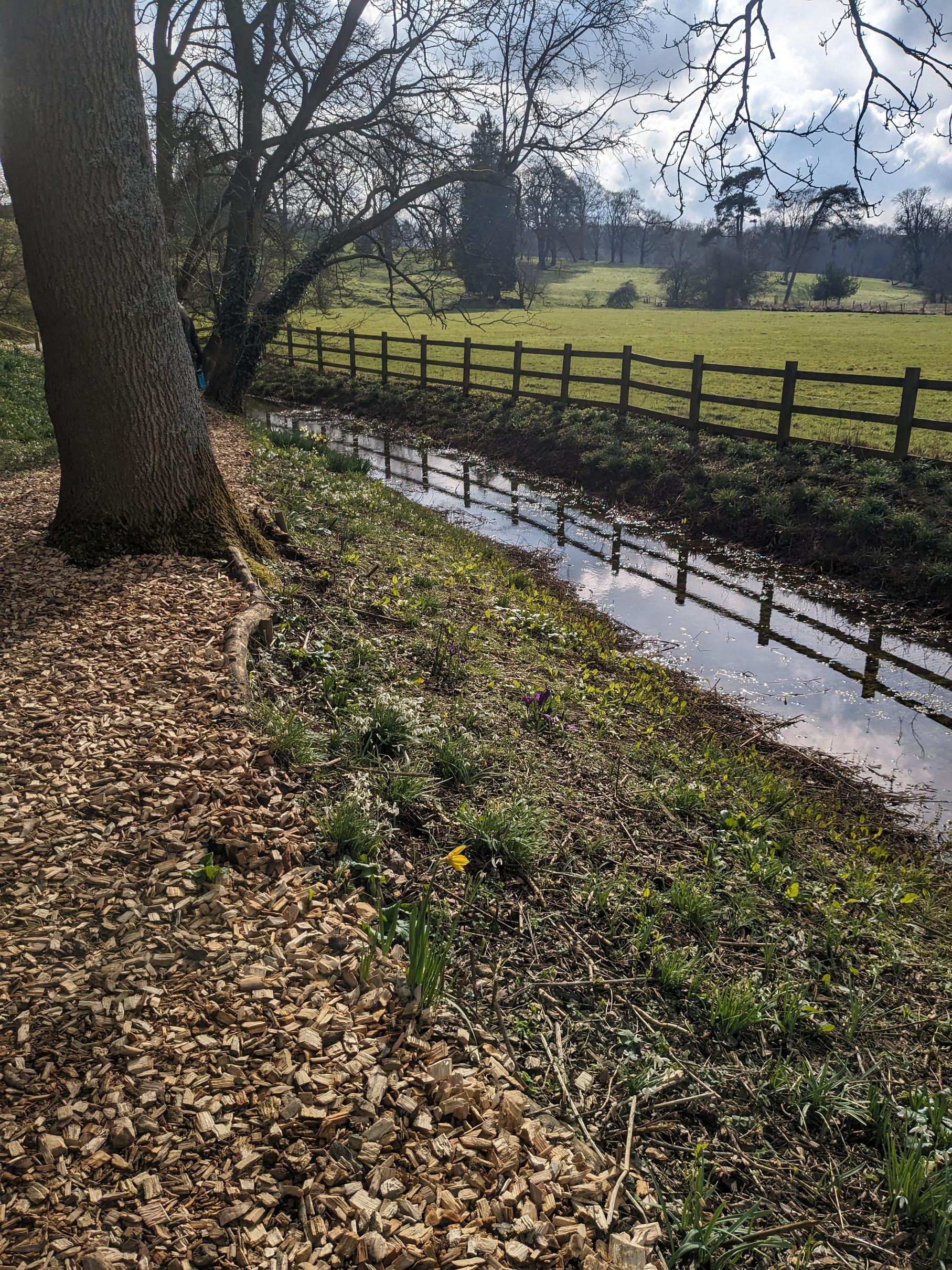
describe a traditional product, brand, type of animal or plant variety, especially one that is old-fashioned, rare and of high quality”
P h o t o C r e d i : C h r i s J e s s o n 8
What heritage means to every one of us may be different. Many of us will link it to old buildings and figureheads, but not necessarily plants, unless we are in tune with gardening. Some of us may link the term to cultural heritage without necessarily being aware of that culture’s historical link to plants. For example, plants in the Middle Ages being grown on an apothecary basis, such as Rosa Gallica var officinalis The cultural heritage of the Middle Ages may be widely known for its features, architecture, fashions and key personnel, but not necessarily in the garden It is perhaps the landscape movement that comes the closest with definitions of their designs and the designers behind them
As a former town planner with an affinity to working with landed estates, listed buildings and the occasional Conservation Area, you could say I am accustomed to heritage. I have long visited and appreciated our stately homes and the gardens that are often associated with them. In elevating this to a career in the built environment I grew to understand that the heritage of the garden was often just as important as the structures and buildings themselves. For example, a listed site may include the garden in the listing in the curtilage, or the gardens may be subject to their own listing if they are deemed to be of particular historic or architectural importance


With such listings I realised that to truly demonstrate the accolade, one must expect exemplary structures but also plants of distinction, mimicking if not truly matching the heritage of the garden itself. Many gardens that are historic or are associated with particular plant breeders will I hope operate in this way.
Heritage can also refer to ‘heirloom’. We are seeing this more and more with exemplar varieties of edibles grown not only for our sustenance but for their beauty as well. She Grows Veg (www.shegrowsveg.com) is making waves in the seed industry for bringing rare, open pollinated heirloom seed to the average consumer and for making edibles beautiful Actions such as this should be applauded, as without this we cleanse the diversity and heritage of what may be on offer to us Gardening thrives on curiosity and innovation May it continue by introducing a little heritage back into your outdoor space
By Chris Jesson @groovygardeninguk
9 Features P h o o C r e d i : C h r i s J e s s o n P h o t o C r e d t : C h r s J e s s o n
This leads me onto my own perspective on what heritage means in a garden context; for this year I have introduced heritage Narcissi in our comparatively new build garden, in their own dedicated place I have bought a series of surplus pre-1930s Daffodil bulbs to introduce to our front garden from the national collection holders, Croft 16 Daffodils of Aberdeenshire as designated by Plant Heritage. This is to sustain the heritage and avoid them becoming obsolete.
Upon a recent late Winter visit to the illustrious Easton Walled Gardens in Lincolnshire, where I recently trained for a year, there are a host of heritage varieties that can be found. Most prominently on my visit were the double Narcissus ‘Telamonius Plenus’ on the edge of the gardens These are known to have existed here since Elizabethan times If the garden’s owner and director, Lady Ursula Cholmeley, had not brought them to my attention I wouldn’t have been quite so drawn to their distinct features You can see from the image below that it is absolutely exquisite


Other recommended varieties are Narcissus ‘Rip Van Winkle and Narcissus ‘Mite’. Both championed by Esker Farm Daffodils over in Northern Ireland for their heritage and individuality in equal measure The former is ever distinctive in the genus with narrow rolled tepals in a firework formation It is also noteworthy for strong green tints in bud ‘Mite’ is a cyclamineus hybrid dating back to at least 1935, and is distinct for its overly long corona and reflexed petals, more so than it would appear in other varieties that exhibit these features. It is a truly excellent small daffodil. In truth I’d probably have all of them. Bring on the daff mania!
Should you wish to have a look through historic varieties Scamp’s Daffodils of Cornwall have a handy selection to peruse.
Features 10 P h o o C r e d i t C r o t 1 6 P h o o C r e d i : C r o t 1 6

Hi everyone, I’m Teddy the One Minute Gardener and I am really my Daddy’s Head Designer I have been gardening since before I was one, even before I could pick up the seeds! I am lucky and have a garden and an allotment that I share with my Daddy
The things that grow really well on my allotment are carrots, golden raspberries, mushrooms and sorrel Sorrel is a type of leaf that you can eat Lemons taste like sorrel Sorrel grew in England long before lemons Apples are my favourite though; I could eat them every day and love bringing my own apples into school
I really enjoy growing dahlias to pick for my Mammy. I have my own raised bed that I grow them in (Daddy helps, a little). I want to grow even more this year and have colour everywhere.
I really love to draw my designs for the allotment or make them out of my Lego. Lego is my second favourite. I am designing a greenhouse to look like the dome my chickens live in. I have drawn designs for a show garden that we will build one day but first I just want to grow lots of fun plants this year
Happy Growing,
Teddy

Wow Teddy, it sounds like you ’ ve grown lots of amazing things. Apples are my favourite too! It’s really cool that you make your designs for the allotment out of Lego. I might try that too!
8
Imogen, Young Folk Champion, says -
Photo Credit: Derek Daly
Creating a sensory garden..
on a budget
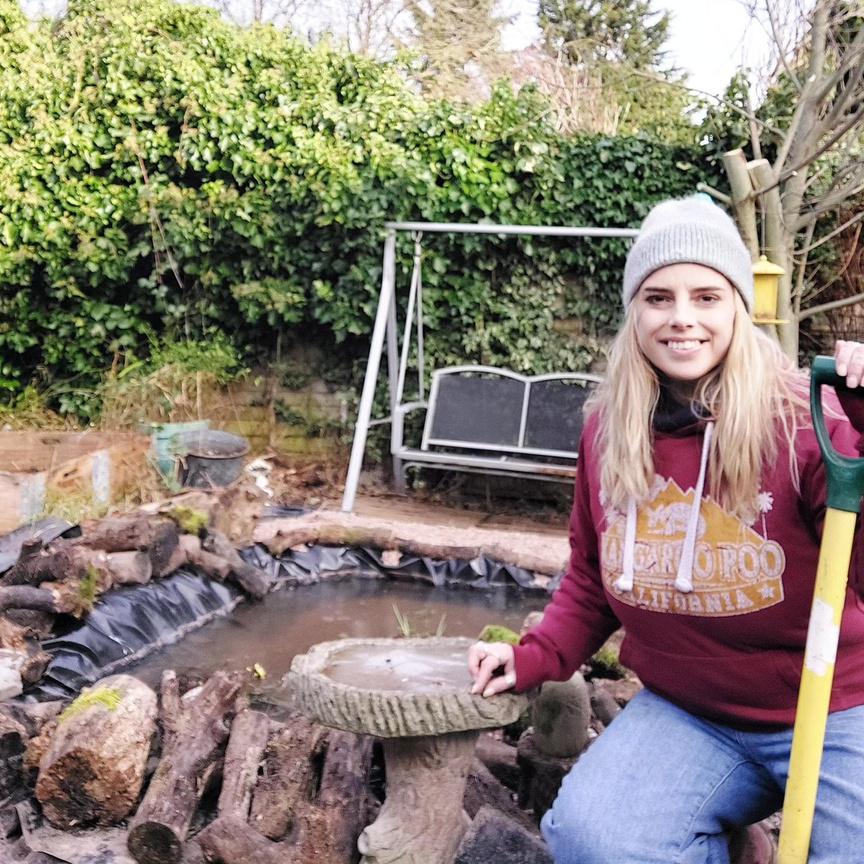 By Fran Anker @thewild gardener
By Fran Anker @thewild gardener
Creating a sensory garden can bring immense joy to those with disabilities and sensory needs and it doesn't have to break the bank! With a little creativity, you can design a sensory garden on a budget that engages and delights all five senses Imagine the gentle tinkling of windchimes and the soft glow of solar lights, the soothing sounds of a water feature and the smell of fragrant flowers. There are so many possibilities when you start considering your garden space in a multi-dimensional way.
In a world that often underestimates the capabilities of individuals with disabilities, a sensory garden sends a powerful message. It embraces inclusivity and celebrates unique experiences. By creating a space that caters to individual needs and allows full engagement with surroundings, we empower each and every person to explore, learn, and grow.
Lets start with plants
Vibrant and fragrant blooms are a feast for the eyes and nose and they can have a powerful impact on our overall well-being. Consider planting a variety of flowers with different colours and scents to create a wonderful sensory experience. From the delicate petals of roses to the bold and cheery sunflower, these flowers will not only add beauty to your garden but will also uplift the spirits of all who encounter them.
Plants for the SENSES

SOUND

TOUCH
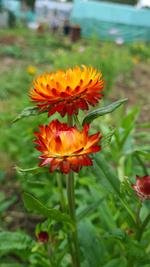
TASTE
SIGHT
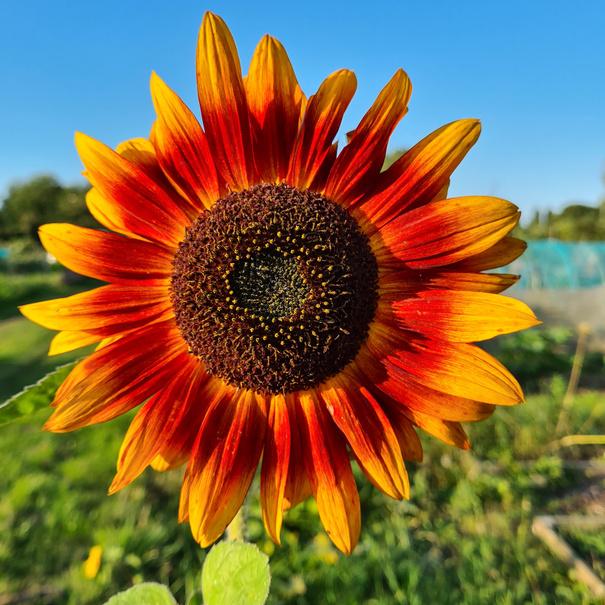

S
12
Ornamental Grasses, Pelargonium, Poppy Seed Heads
Chocolate Cosmos, Lavender, Rosemary, Sweet Peas
Lambs Ear, Jerusalem Sage, Silver Sage, Strawflowers
Mint, Chives, Strawberries, Nasturtium, Viola
P h o t o C r e d t : F r a n A n k e r h o o C r e d A y h m o o r e PhotoCredi ElenMaryWesber P h o o C r e d A y P h m o o e P h o o C e d A y P h m o o e P h o o C r e d A y h m o o r e
Swiss Chard ‘Bright Lights’, Sunflowers, Lupins, Dahlias
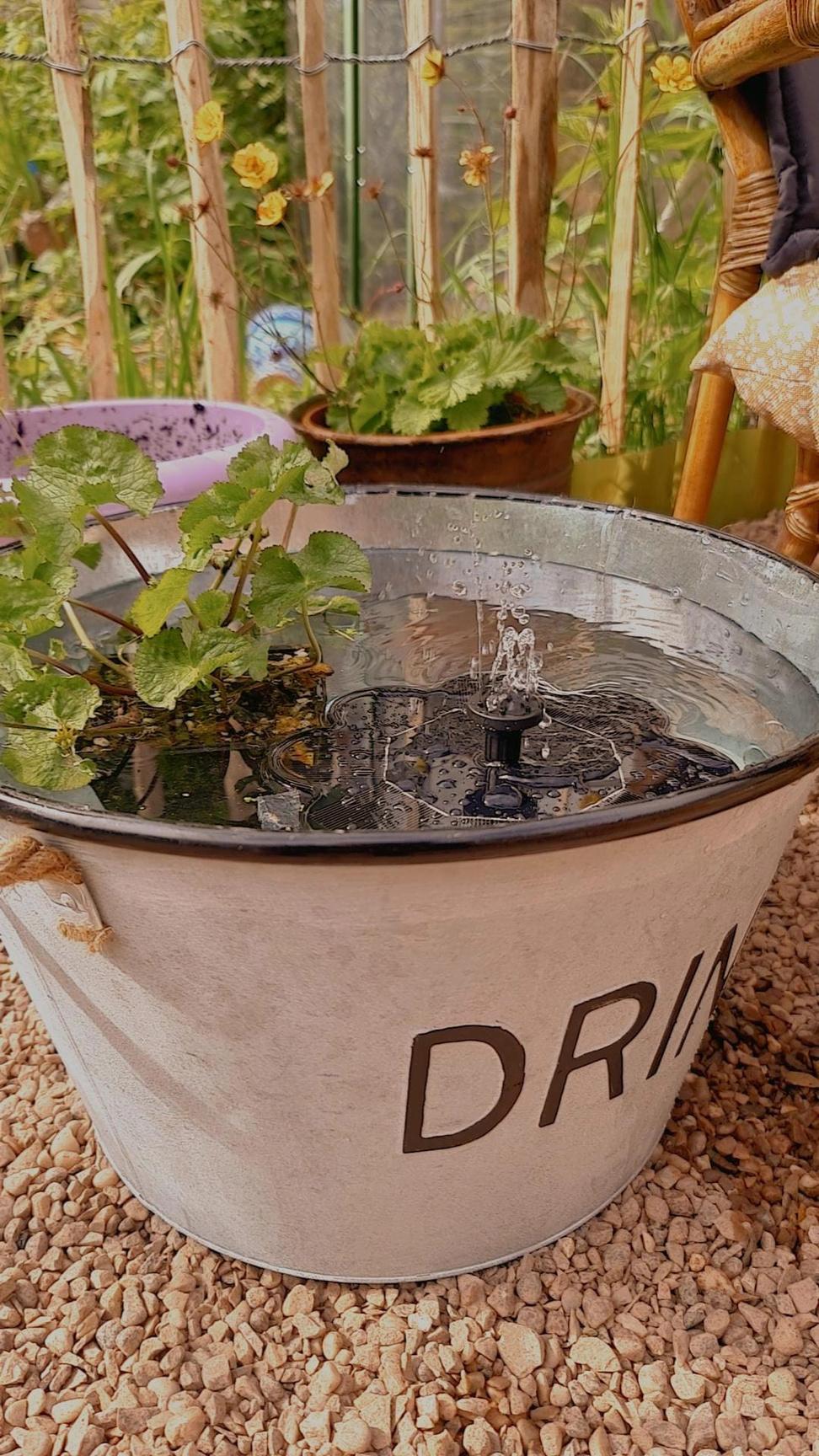
Decor
Add windchimes to the high branches of surrounding tress and enjoy the gentle tinkling sounds in the breeze. You could also hang suncatchers and mirrored items to reflect the light and create subtle interest.
Items such as plastic windmills and bunting are often found in budget stores and are great value for money Dotting them around your garden will create a wonderful spinning/fluttering motion in the breeze
Solar fairy lights are a must for evening relaxation and create a stunning cosy vibe, as well as extending the amount of time you can enjoy your garden Snuggling up under a blanket surrounded by fairy lights is the perfect end to a busy day of gardening You could even add a fire pit and you can buy eco-friendly colour changing fire dust or logs to add some extra excitement!

Wildlife
Adding things such as a bird feeder, bug hotel and a pond, if your budget allows, will add some extra interest and excitement to your garden
A pond doesn't have to be expensive You could re-use an old washing up bowl, add some rocks and stones and a slab of wood for insects and frogs to get out
Solar powered water fountains (which you can find easily online) are very budget friendly and provide a wonderful experience to those who are watching.

Planting Areas
Using pots and raised beds can make things a lot easier for those with mobility issues or limited hand movements. Try putting your plant pots in an arch shape to create an enclosed area for relaxing, observing, and listening to your surroundings as well as adding some privacy within your space.
So, whether you are starting with a blank canvas or transforming an existing garden, remember that every plant, every texture, and every sound can contribute to the joy and well-being of those with disabilities.
Together, let's build a world where everyone can experience the beauty and wonder of a sensory garden, regardless of their abilities or limitations
Garden Inspiration 13
P h o t o C r e d i : F r a n A n k e r P h o t o C r e d t : F r a n A n k e r P h o o C r e d t : F r a n A n k e r
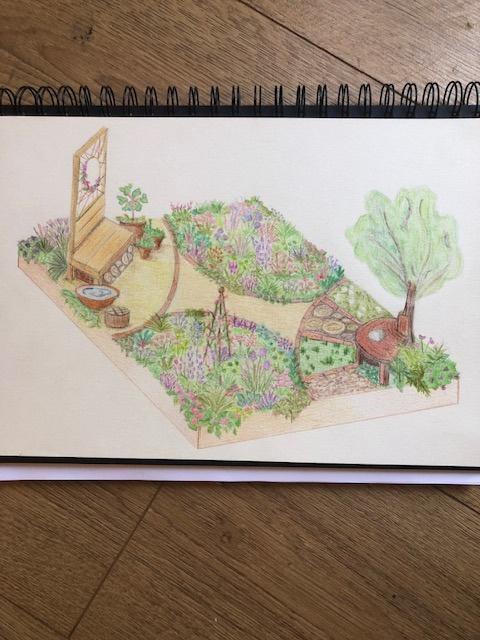
We are incredibly lucky here at Garden Folk Mag to have so many talented gardeners in our midst. This year several of our lovely gardening community are taking the plunge and designing show gardens at BBC Gardeners World Live and they’re sharing the whole process with us in the magazine over the next few months. First up, we have Leanne with her garden “Following in My Footsteps”
Are you inspired?

P h o o C r e d i : L e a n n e W o o d P h o o C r e d i : B B C G a r d e n e r s W o r l d L i v e Use GARDENS20: 20% off standard adult/concession entry tickets (excl. Saturday) expires 9th May 2024
I love a good show!
Over the last couple of years, I’ve been lucky enough to visit many horticultural shows Each time admiring the amazing variety, creativity and work of the designers, landscapers and nurseries Every show has its own character, from the stunning backdrop of Malvern to the craziness of Chelsea They are fantastic places to make and meet friends, gain inspiration and talk to a whole host of industry experts. The energy and atmosphere created is something rather special. We all know that the gardening community is the best and it’s especially visible at the many gatherings during the growing season. Needless to say, I’m a garden show addict! But I’ve always wanted to know what it takes to design and build a show garden…
Planting a little se
On a scorching hot day in last year, whilst lending a h on a show garden build at NEC, I dared to dream a border of my own creatio Throughout the week I had watched the beautiful borde being created Each designer had such original ideas, huge enthusiasm, and seemed to be having a blast in between the inevitable stressful moments. No sooner had this mad thought popped into my head than it had left it again, I was back to the day job and being mum. Until I saw a post on the BBC Gardeners World Live Instagram page!
Initial design ideas
Once I started to seriously think about the theme for the border, my brain went into overdrive I had way too many ideas; I was like a child in a sweet shop; I wanted everything I take my hat off to all designers; the restraint needed is phenomenal After filtering the gazillion ideas, I decided to focus on what I know most about: a shared space for my family, calling on my own past experiences of gardening with my grandparents and celebrating the things I love most about gardening.


Plotting and planning
Now I’m absolutely no garden designer but I have enjoyed plotting and planning my own space and that of family members. The post, calling for beautiful border applications, sat in my head for a couple of weeks, ticking away in the background. Should I Shouldn’t I The imposter syndrome and utter fear of putting myself out there were all good reasons not to enter. But I found myself doodling and brainstorming more and more until I had to face the fact it was something I really wanted to have a go at. There was no guarantee that my design would be accepted and, if truth be told, I didn’t really believe it would be, so there was nothing to worry about, right
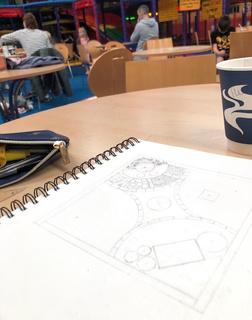
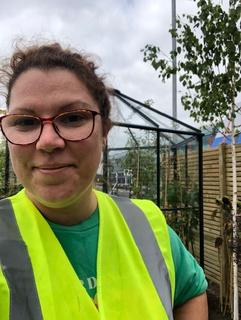
The application process I’ve always adored drawing and designing on paper. At school, I loved art and graphic design but like many, life gets busy and these hobbies sadly end up being forgotten. But now I found myself drawing and designing in the most unusual of places…in the school staffroom, soft play areas, even in a hospital waiting room. Forming the initial planting plan was a little daunting and I spent a lot of time googling plants to make sure they were going to flower at the correct time I visited lots of garden centres and trawled the housands of photos I have on my hone from countless garden visits d shows The application process was actually very enjoyable and elatively simple, there was lots of from the team at BBC GWL The d come to hit the send button and cross my fingers.
The email response
I hadn’t told many people about my mad idea - probably only 2 or 3, so I didn’t have to worry about saying I hadn’t been successful I wasn’t expecting an email back for a good couple of weeks so when one popped up in my inbox after just a few days, I was sure that it was a thanks but no thanks. It was a good job that I opened this email during my lunch break; I screamed, then cried and then swore! Since that moment, it’s been a blur of emails, lists and seeking advice. The Gardengram community on Instagram is such a supportive place and part of the reason I’ve felt confident enough to give this a go. I am totally thrilled, slightly nervous but loving being on this mad journey. And that brings us up to the present, now the hard work starts creating my garden ‘Following in my footsteps’.
Garden Journeys
? ? ? 15
By Leanne @my l ttle patch of earth
Ph C d L W d
PhooCred LeanneWood
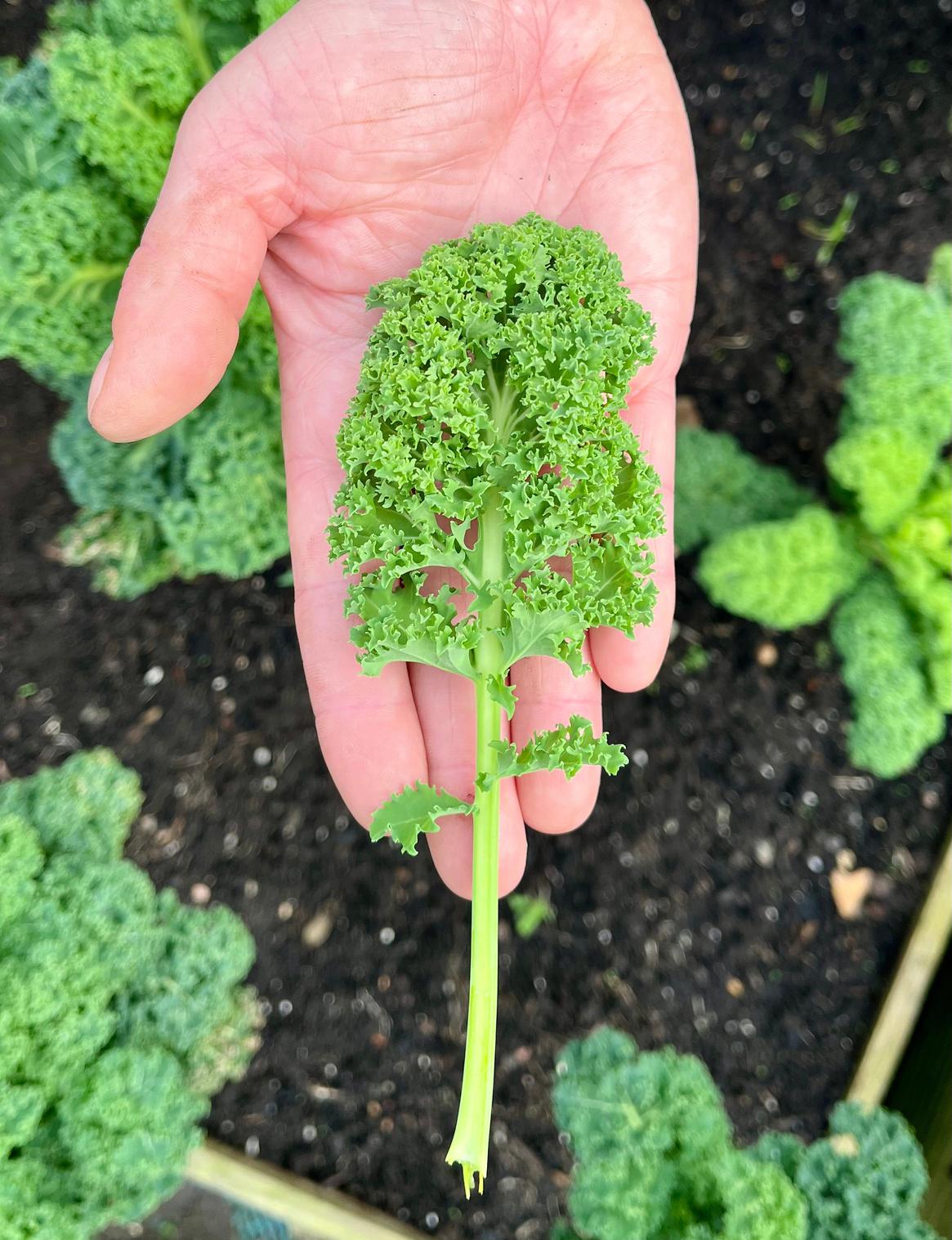
All hail king kale!
I am a huge fan of Kale. It’s easy to grow all year round with excellent productive varieties, and so for me it is the perfect Plot to Plate Superfood.
P h o o C r e d i : S u s y B
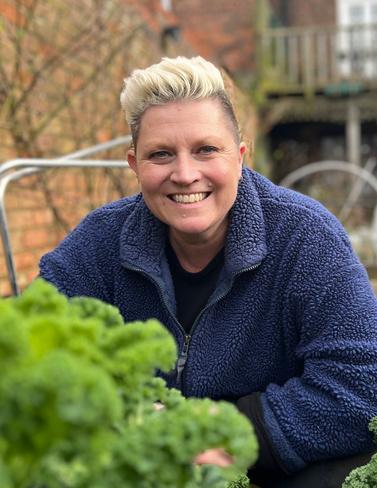
When to sow
I sow 4 times a year The first sowing is in December/January under grow lights, specifically for small leaves for salads I grow all the above varieties close together because I’m looking for tender leaves that I can harvest in April-June. Succession sowing a couple of weeks apart helps to stagger the harvest.
My Early maincrop sowing for Kale takes place in March This is for harvesting from July Plants are spaced further apart to allow room for the plants to develop fully My main crop sowing is mid - June/July to harvest in late autumn onwards but especially in Spring My final sowing is in August/September This is when I sow my main crop Cavolo Nero and a repeat sow the Curly Kale varieties. This is for harvest in Spring or December/January if grown undercover.
Planting tips
I sow in 11cm pots and then prick out into modules. I use the Moon Phase gardening calendar, so I always sow on a Leaves day. Transplanting (also on a Leaves day) I plant quite deep up to the first true leaves and cover with mesh to protect from birds and caterpillars.
Harvesting
I always look for glossy leaves and harvest the leaves from the bottom up without taking out the head This keep’s the plant producing leaves and cropping for months on end For the Red Ruble salad leaf, I treat it like a cut and come again salad mix and give it a regular trim and it comes back in couple of weeks
Storing and cooking
After picking, the leaves must be refrigerated and used as soon as possible. Alternatively, I find it freezes really well. I just remove the leaves from the stalks, roughly chop and pop into freezer bags It is great in soups, green smoothies, kale crisps, Indian curries – I mix with spinach and spices to make Saag, pies and tarts Home grown Kale is nothing like the stuff you get in the Supermarket It really is extremely tasty and versatile, and it is full of vitamins and antioxidants
Varieties to grow
Curly Kales
Dwarf Green - very productive Reflex F1 - early variety
Scarlet - beautiful looking variety
Pentland Brigg - best for taste

Salad Leaf
Red Ruble great for Spring salads
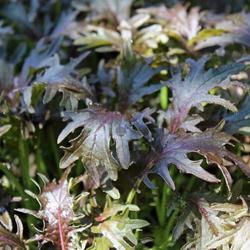
Cavolo Nero
Dazzling Blue - a good looking plant so can be interplanted in your flower boarders
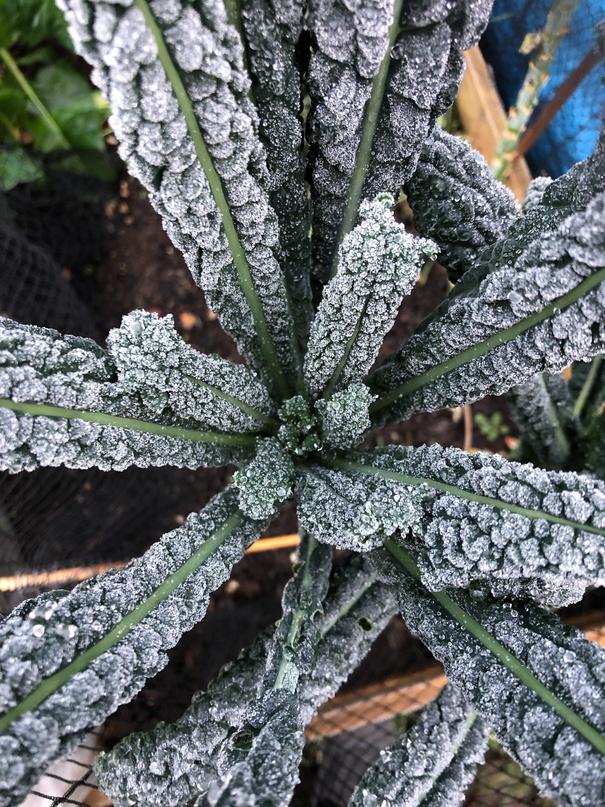
c- my favourite ero productive very tasty
This Month 17
@susybliving9848
P h o t o C r e d i : S u s y B
@susyblving susybliving susybliving
Photo Credit: Susy B
Kale and Lemon Risotto
I have a number Kale recipes on my website and I have chosen this fantastic Kale and Lemon Risotto to share with you:
180g Kale leaves (remove from stalks) roughly chopped (Dwarf Curly or Pentland Brig work really well)
60g Butter
2 shallots, finely chopped
2 celery sticks, finely chopped
2 garlic cloves, finely chopped
2 unwaxed lemons, zest (both), juice of 1 200g risotto rice – I use Canarolli
100ml dry white wine
1l chicken or vegetable stock
70g pecorino, grated, plus extra to serve
2 In a food processor, or using a stick blender, blend until you have a puree, adding a splash of water if you need to, set this aside.
3 Gently heat the stock in a saucepan.
4 In a separate large saucepan melt 30g of the butter and fry the shallot and celery for about 8 minutes, until soft
5 Add the garlic and half the lemon zest, fry until fragrant, then add the rice and stir and fry this for a few minutes until the edges of the rice are turning slightly translucent
7 Next start pouring in the stock a few ladlesful at a time, constantly stirring.
8 After each ladle is absorbed into the rice, continue adding stock and stirring until the rice is al dente. This should take 12-15mins.

1 Bring a large pan of water to the boil then blanch the kale leaves for a couple of minutes, drain, then refresh in ice cold water

6 Pour in the wine and let it bubble down and evaporate
9 Stir in the kale puree, heat through, and then stir in the remaining butter and the pecorino Check the seasoning and add salt and pepper if required and then add the lemon juice to taste, scatter over the remaining lemon zest and serve with some extra grated pecorino on top I always add a little sprinkle of chilli flakes too for a little spice kick
18
This Month P h o o C r e d i t : S u s y B


It's been another very wet and quiet month on Plot 40a, so I haven't been able to do anything except plan and sow seeds! I've obviously been composting like crazy too!
My new plans are to top up the Garantia raised beds with a topping of fresh compost and finally get my garlic, onions and shallots in. With these beds being so much taller, it means I'll have less risk of waterlogged soil. Part of the plan is to wait until it dries a little and strim the grassed areas in between the raised beds. Once that is done, the grass clippings will go into the compost bays and I will then be able to lay cardboard between them and cover with woodchip This will allow me to raise the level up and also give me a weed free and dry pathway throughout this raised bed area
The next part of the plan is to remove the raised beds that we put in last summer and make 4 long beds, going across the plot These will be no dig and the homemade compost that currently fills the beds, will be used as a base for the newly positioned ones I also have a compost bin at home, filled with compost that has been sat for three years This is going to be moved to the plot and added to the beds As well as this, we have two dalek compost bins that will be emptied into the new beds too These empty plastic compost bins can then be used for leaf mulch in autumn. Once the new beds are in place, I'll be able to create more paths between them by repeating the cardboard and woodchip process. I'm hoping that I can recreate last year ’ s squash arch over the paths between these new beds.
A big job I am now able to crack on with, is the brassica cage I'm hoping the ground will be dry enough so that I can level off an area at the bottom of the plot and build the brassica cage, using the old chicken enclosure. I have been lucky enough to make a connection with ‘Collins Nets’, who have kindly sent me the netting required to cover the framework to keep the pigeons out. Inside this will then have a horseshoe shaped no dig bed created with a woodchip pathway through the centre. I'm hoping by building this, I'll finally be able to grow some decent cauliflower, cabbages and broccoli
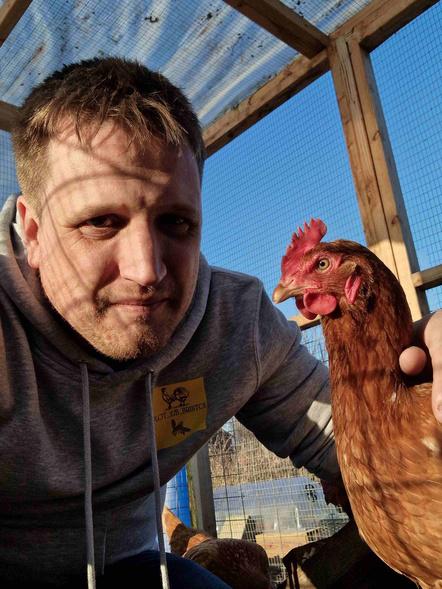
With all this productive planning taking place, there will need to be a bonfire to get rid of all the wood off cuts, tree prunings and rotting things, such as a table, pallet wood bench and also an old chicken coop from plot 27b! With the amount I need to burn, I'll probably just do it directly on the ground instead of using the incinerator Once it's finished and cold, I'll sieve the ashes and add them to the soil around vulnerable seedlings The space will then finally be clear to add the greenhouse There will also be space for a shed, and a small area for the children to play and relax in
Fingers crossed for a much dryer month ahead, so real headway can commence and jobs can be ticked off the list!
This Month 19
@p ot b b sto P h o o C r e d i : B e n S h u l e r
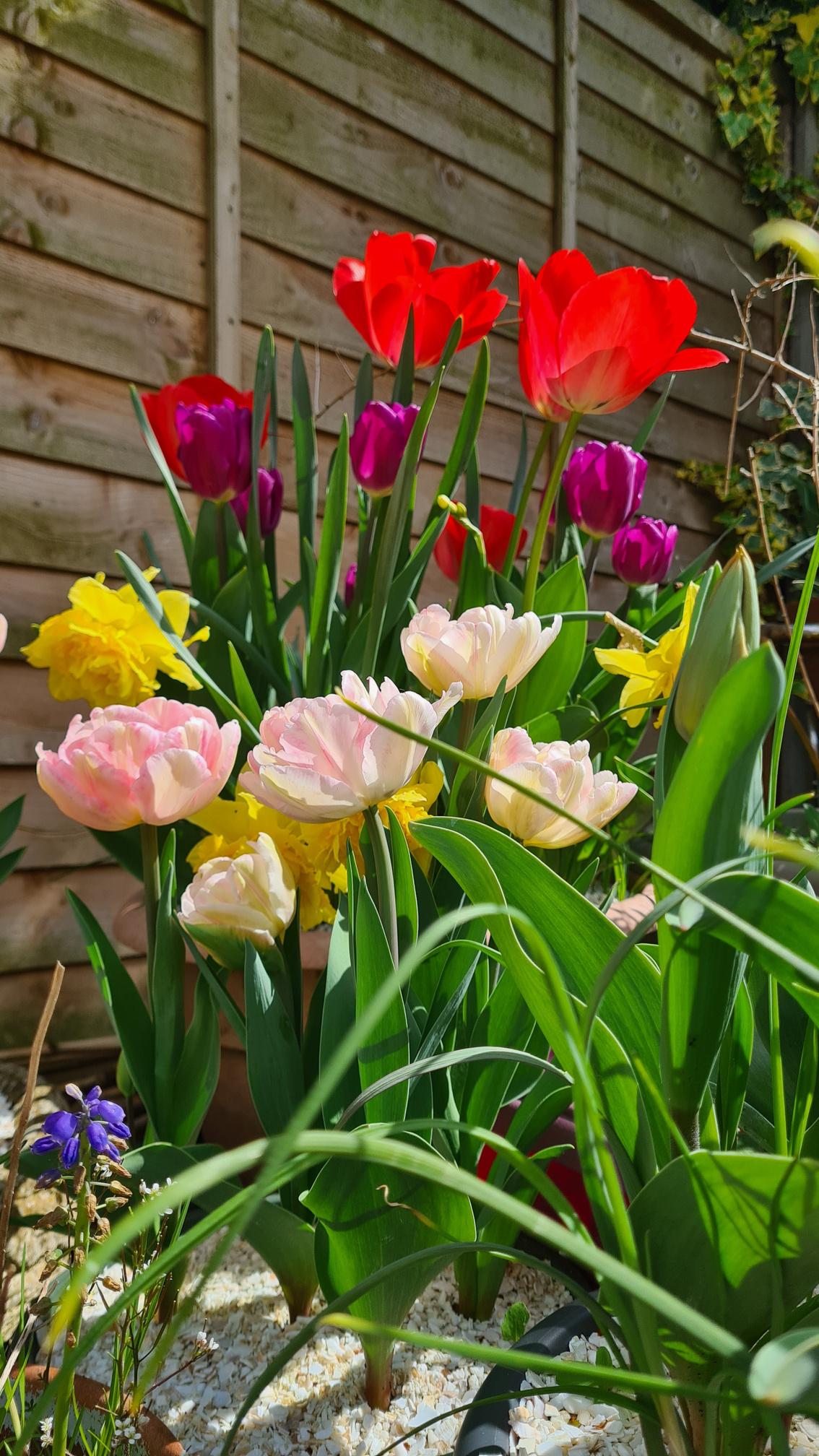

15 Spring photo projects
Welcome to the whimsical world of garden photography, where every flower poses like a supermodel and every leaf has a story to tell If you're like many green-thumbed enthusiasts, you've probably spent countless hours tending to your botanical brood, but have you ever thought about capturing their beauty through the lens? Fear not, for you're about to embark on a delightful journey that blends your passion for gardening with the art of photography
Think of it as a photoshoot for your plants – the divas of the dirt, the stars of the soil! From the dramatic flair of a blooming rose to the comedic charm of a mischievous squirrel nibbling on your prized tomatoes, there's never a dull moment in the garden. So why not document these magical moments and create a visual diary of your horticultural adventures?
Grab your camera and let's embark on a botanical escapade that's sure to bloom with joy, beauty, and maybe even a few unexpected surprises along the way by diving into this curated list of garden and plant photography ideas. From capturing the morning dew on delicate petals to experimenting with creative angles and perspectives, these quick tips will breathe new life into your snapshots. So why wait? Let's uncover the hidden wonders of your garden through the lens and unleash your inner photographer with these 15 ideas to keep you inspired!
20
P h o o C r e d i : A l y P h i l m o o r e taylamaccom
@earthyencounters
2
1
Fruitful harvest
If you have fruit trees, capture the blossoms and budding fruits. Adjust your composition to include both the flowers and emerging fruits.
The potting bench
Rustic or modern, highlighting the charm of your gardening tools and potting area can be fun and inspiring. Shoot during the softer light of early morning or late afternoon
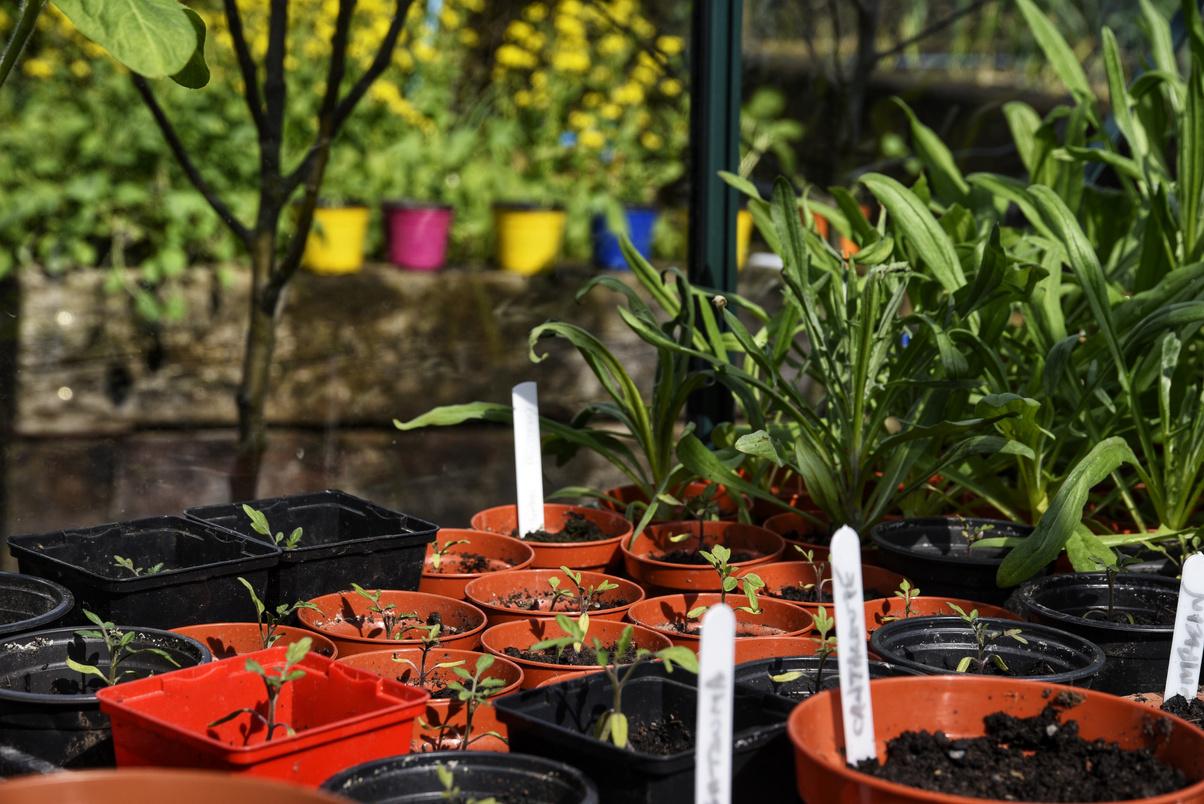
3

4
Morning dew delight
Early mornings are perfect for photographing dewdrops on leaves Use a macro lens or setting and set a fast shutter speed to freeze the delicate droplets
6
Cherry Blossom Elegance
If you have cherry blossoms, capture their fleeting beauty. Use a wide aperture to isolate individual blossoms against a dreamy background
Springtime raindrops
Embrace rainy days and capture raindrops on petals. Use a fast shutter speed to prevent motion blur.
Garden chronicles
Document the growth stages of your vegetables and flowers. Set a consistent shooting location to create a cohesive series
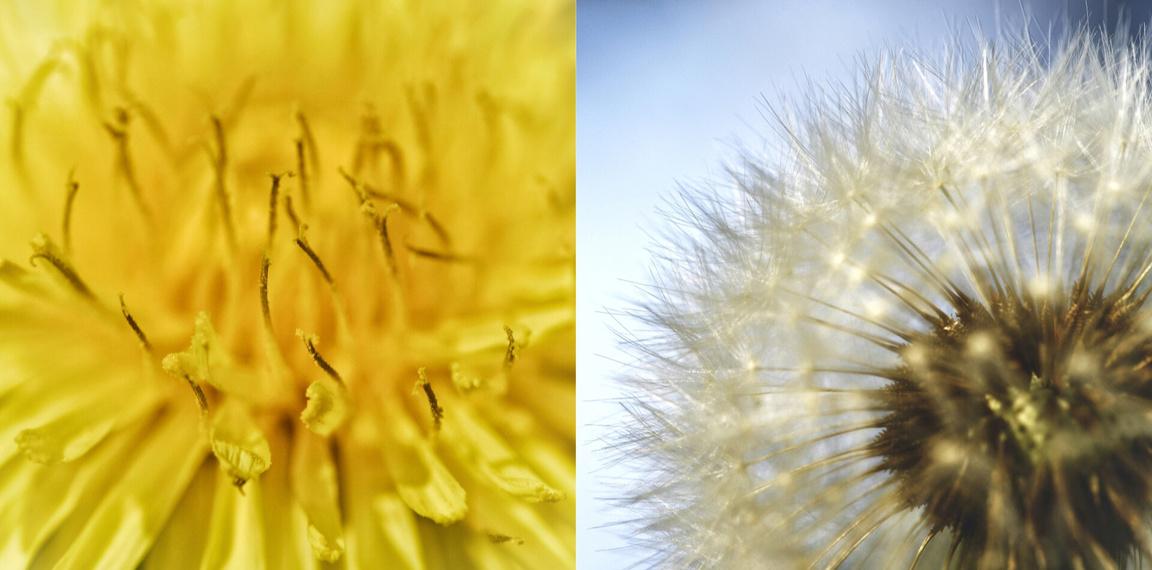
Garden Projects 21
5
P h o t o C r e d t : T a y l a M a c P h o o C r e d i : T a y a M a c P h o t o C r e d i : T a y a M a c


10
7
Visitors who flutter less
Photograph any small animals or insects that visit your garden Patience is key,and a macro option can reveal fascinating details
Leafy Textures
Explore the intricate details of leaves. Use a tripod for stability and experiment with different angles and lighting to emphasize textures.
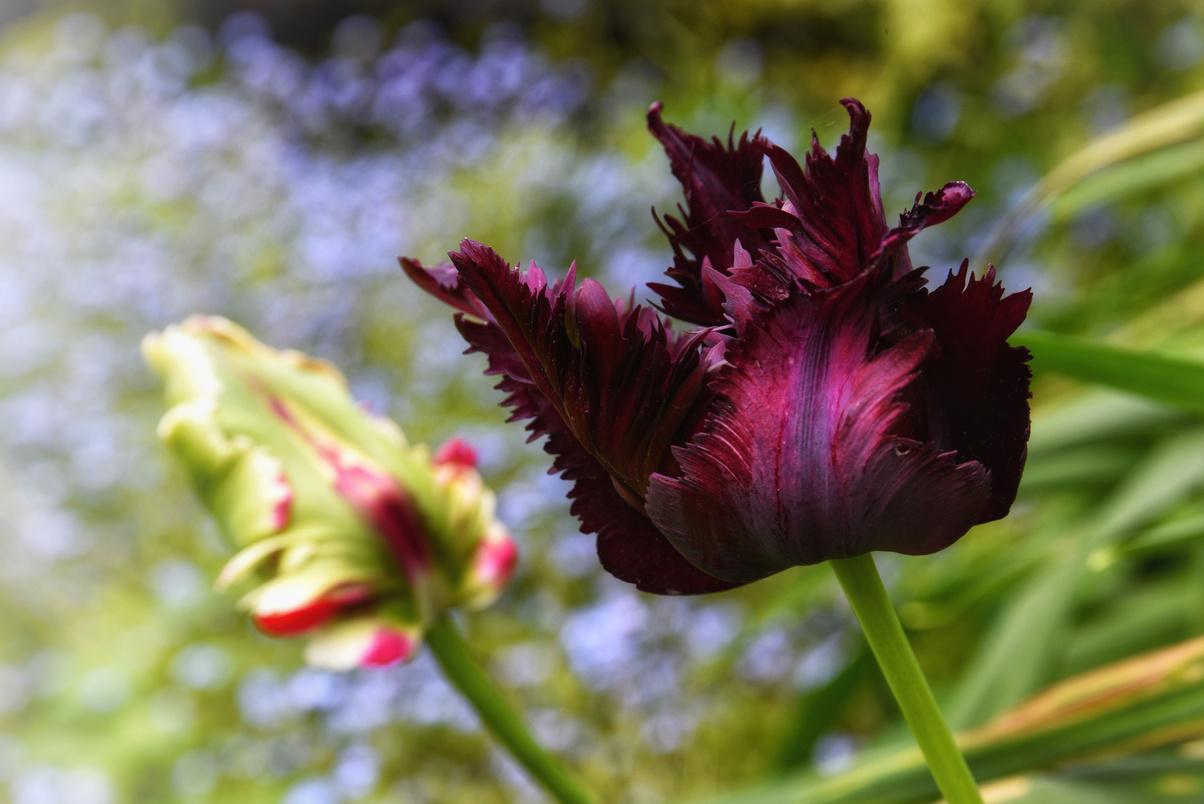
Tulip Time
Focus on the vibrant colors of tulips. Try a mid-range aperture (e.g., f/8) to maintain sharpness across the frame. .
Budding beauties
Capture close-ups of blooming flowers with a shallow depth of field to make them stand out Set your camera to a low aperture (e g , f/2 8) for a beautiful bokeh effect
12
11
Herb garden close-ups
Highlight the details of herbs like basil or thyme Employ macro for intricate shots and adjust your aperture for the desired depth of field.
Those who flutter more
Document the various butterflies and bees attracted to your garden Opt for a fast shutter speed to capture their quick movements
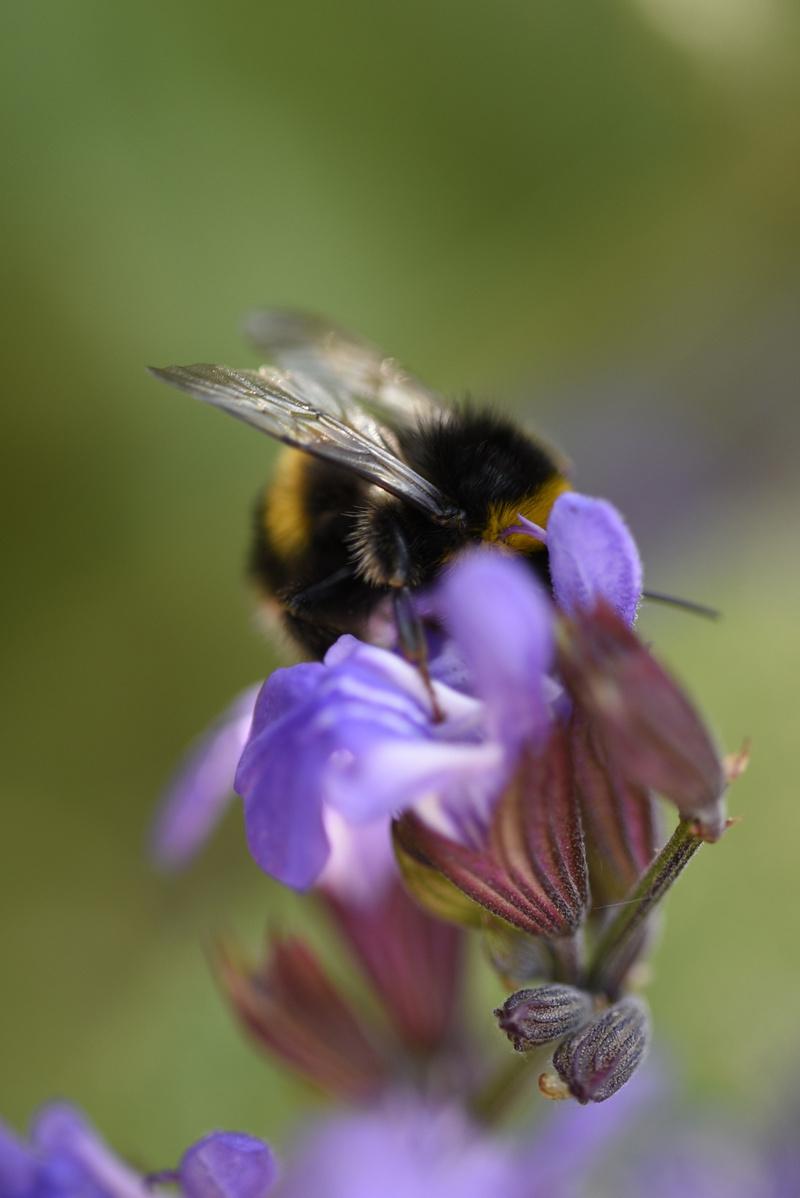
22
9
P h o o C r e d t : T a y l a M a c P h o t o C r e d t : T a y a M a c P h o o C r e d i : T a y a M a c P h o o C r e d i t : T a y l a M a c
13
14
Backlit blossoms
Shoot flowers with the sunlight behind them for a beautiful backlight effect. Adjust exposure to avoid overexposing the highlights.
In full bloom
Showcase the overall beauty of your garden by capturing wide-angle shots. Opt for a smaller aperture (e g , f/11) to ensure sharpness throughout the frame
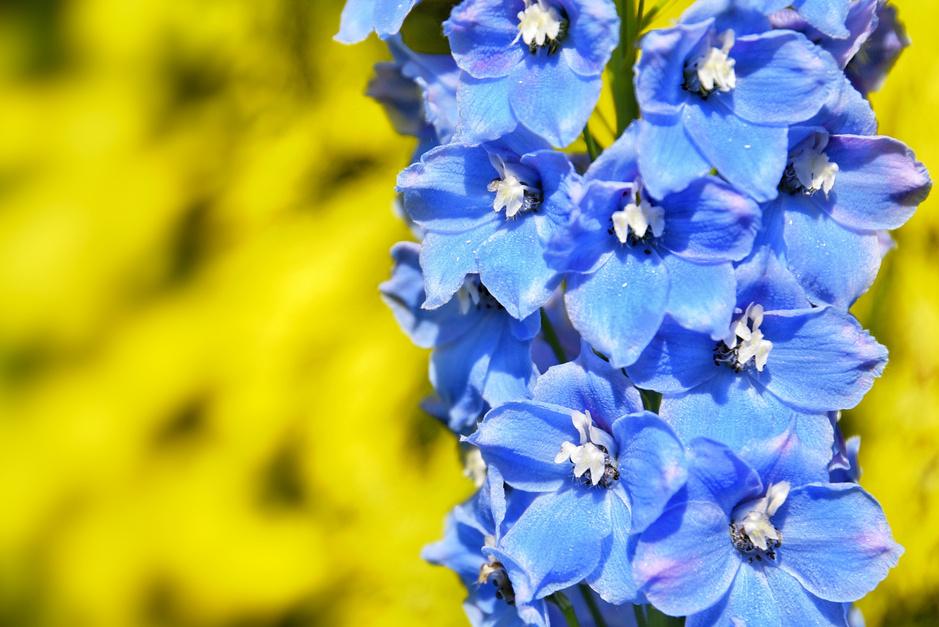
Remember to experiment with these suggestions, adapting camera settings to suit your creative vision and the specific conditions in your garden
As you venture forth with camera in hand, may the vibrant colours, delicate details, and whimsical wonders of your awakening garden ignite your passion for photography Let each snapshot be a celebration of nature's artistry and your creative vision. Happy shooting and don't forget to share your captures to #GardenFolkFriends for a chance to be featured!
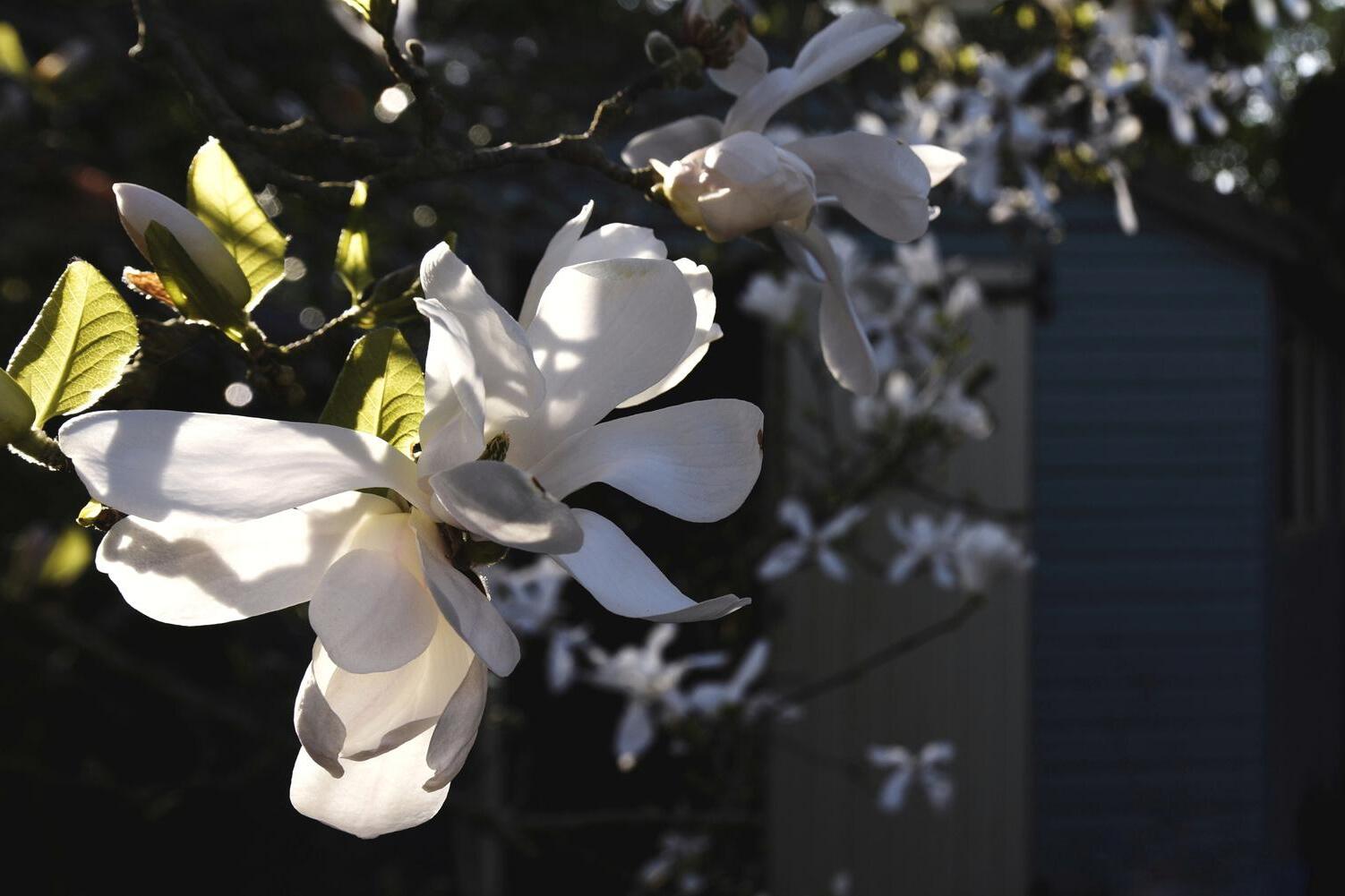
15
Contrast in colours
Play with colour combinations in your garden. Compose shots that feature contrasting colors for visual impact
Tayla Mac is a photographer with over 15 years experience. She offers 1-1 mentoring sessions in learning photography and becoming a professional. To learn more, buy prints or to collaborate on a project, please head over to Tayla's website or Instagram profile @earthyencounters and send her a message
Garden Projects 23
P h o o C r e d i t : T a y l a M a c P h o t o C r e d t : T a y l a M a c P h o t o C r e d t : T a y l a M a c



One of my all-time favourite gardening projects, is the ever-popular sweet pea teepee It’s such a simple yet effective structure which just looks stunning for so many months of the year. What’s more, you get a fantastic harvest of cut flowers, and the seeds are really easy to save for future years too. We’ll be creating our own version of the sweet pea teepee at The Gardeners Co ’ s new garden, as well as over on @diaryofaladygardener’s allotment for 2024, so be sure to give us a follow on socials to see how it all turns out!
P h o t o C r e d t : T h e G a r d e n e r s C O I C
You will need:
Sticks
String
Compost
Scissors
Sweet pea seeds
Pots
How to make a sweet pea structure
1 2 3 4 5
To get started, mark a horseshoe shape using a peg and a piece of string in the centre of where your structure will sit, this helps to get a nice even circumference Then you can either dig out the horseshoe shape, aiming for a depth and width of 20-30cm, or start to build up the border to make a raised bed Don’t forget to leave enough room for an entrance if you’d like to be able to sit inside!
Fill your trench with a layer of cardboard and fresh compost to replicate no-dig gardening and then start skewering the canes at even intervals into the ground. You can choose how densely you pack the sticks, whether it’s 10cm apart or 30cm apart. Gather the sticks approximately 10cm from the top and secure them with string, be sure to wrap your string tightly around the bundle of canes at least 5 times before securing with a knot. Then, starting at the bottom, weave your string in and out of the canes to create a trellis-style structure where the plants can climb. we’d recommend starting this around 20cm above the compost level and continuing at 30cm intervals until you reach the top
Once your sweet pea plants have been hardened off and are ready to go into the ground, simply detangle the roots if multi-sown and plant them into each hole, firm in, and water You can also direct sow into the trench - we like to sow garden peas in between our sweet pea plants for a little extra diversity (just remember not to eat the sweet pea pods!)
When your plants are 10-15cm in height we encourage you to pinch out the tips. This encourages bushier growth with more flowers and is especially important if your seedlings are looking a little on the leggy side as it’ll help them to bulk out.
Throughout the season you’ll need to spend some time tying in your plants to ensure they climb upwards We’d also recommend giving them a feed every few weeks and cutting the flowers constantly as this will maximise the number of flowers you get throughout the year
If you ’ re limited on space, you could easily make a mini teepee with canes in a pot, or maximise the vertical growing space by creating an archway between pots or beds! Don’t forget to let us know if you get building @thegardenerscocic and @gardenfolkmag!
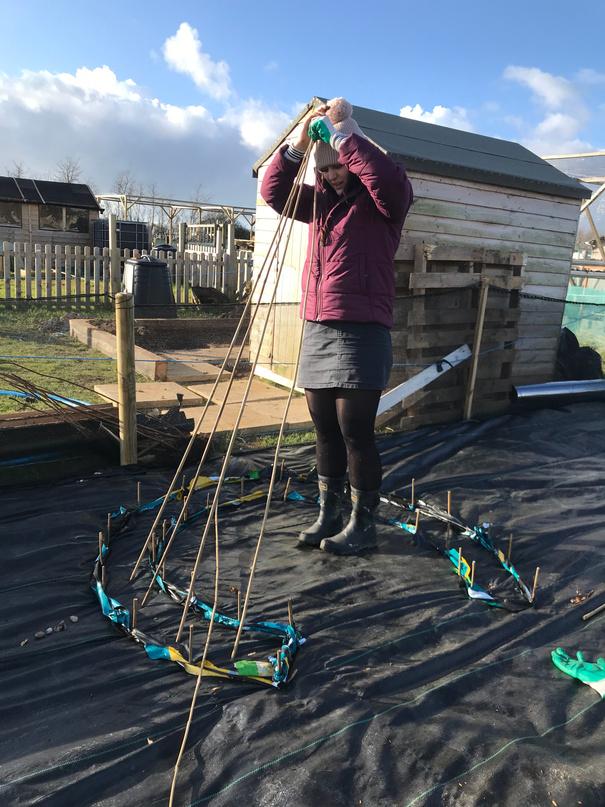
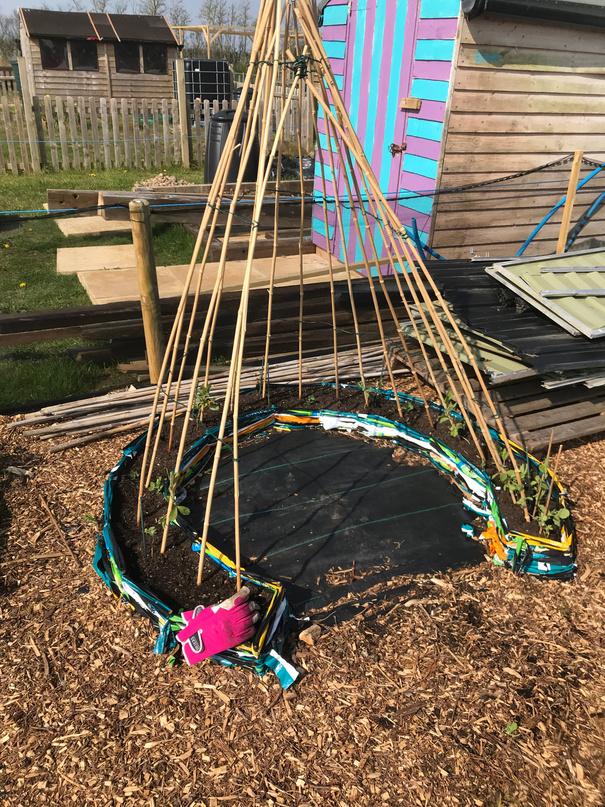
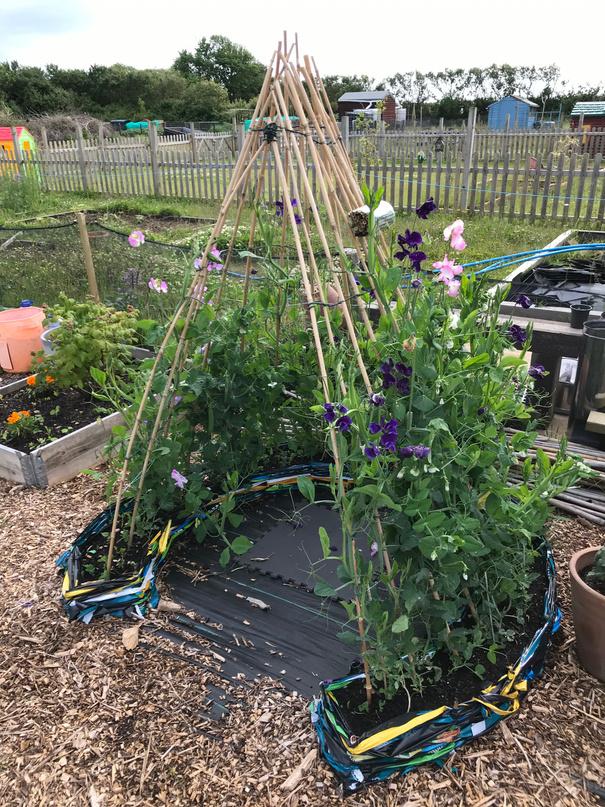
P h o o C r e d i t : T h e G a r d e n e r s C O I C P h o t o C r e d i : T h e G a r d e n e r s C O C P h o o C r e d t : T h e G a r d e n e r s C O I C Garden Projects 25
Top tip: In 2019, we upcycled reusable carrier bags to create a woven border, and in 2022 we used woven willow canes which were surplus in a school garden so there are plenty of ways to get creative with your build
Top tip: You can make homegrown confetti with sweet pea petals simply by taking them somewhere warm to dry out or popping them into a dehydrator The colours intensify and they retain their scent for a few weeks after drying!



By Emanuelle Paulson @emanuellepaulson emanuellepaulsoncom
The end of February has brought hailstorms, high winds and plenty of rain down my neck of the woods in Cornwall. But it has also brought with it a few of those glorious sunny days where spring really feels like it is around the corner. I know for most of you, depending on where you are, March may not feel like spring either, but in the foraging world the season has already begun (if it had even ended!). Spring is really springing… and with it brings an absolute abundance of foraging goodness. This is possibly my favourite time of the year to forage, as there is such a range of wild plants, many of which can be preserved to be used later in the year There are also pops of colour as primroses, dandelions and magnolias burst out from their slumber The occasional winter/spring mushroom can be found too, which can be a welcome surprise The possibilities feel endless, and there is so much to learn and explore Spring is in the air
I’ll start with a plant that gets a lot of attention at this time of year - wild garlic! You may or may not be familiar with this lovely wild food, but it has been poking out of the soil in shady areas and woods for a couple of weeks now, and its season will extend well into June in some locations
Wild garlic or ramsons (Allium ursinum), is a perennial plant in the onion family. It is quite recognisable, growing in glossy green clusters in damp areas, often in woodlands or near streams. The leaves are long and broadly lanceolate with a single main vein; they are much narrower when younger. The flowers come out a little later on and are white with six petals in globe-like clusters. The main giveaway for wild garlic is the smell. Pungently garlicky, you can usually smell it while walking through deciduous woodlands, or if you pick any and rub it between your fingers.
Although the smell of wild garlic makes it distinctive, the shape of the leaves and habitat mean it can be easily confused with a few other plants Lily of the Valley (Convallaria majalis) looks quite similar but doesn’t smell of garlic and I find the leaves to be more robust and less clump-forming The sweet-smelling bell-shaped flowers will also be a giveaway when they come out Lords and ladies (Arum maculatum) is another sneaky lookalike, although the veins on this leaf are different Dog’s mercury (Mercurialis perennis) also loves to grow in the same environment Although on closer inspection these plants don’t look or smell like wild garlic, they can often be collected in error by the mindless forager who grabs handfuls without looking And being toxic or poisonous, you don’t want to be accidentally including them in your wild garlic pesto! So, when picking wild garlic, I really encourage you to pick one or two leaves at a time, and enjoy the mindful process of doing so. Finally, when you take your harvest home, check through it a second time to ensure you haven’t missed any stowaways - you’d be surprised how often this happens!
A final point is that you should always be mindful of how much you are picking, and this applies to any wild food. Some people go by the rule of thirds, which means only taking up to a third of something and leaving the rest to grow and store energy. Others go by the 10% rule instead. I think the secret is just to always think about who or what else relies on this food source or environment, as well as how can you best protect this plant and its habitat so it will flourish and thrive for years to come!
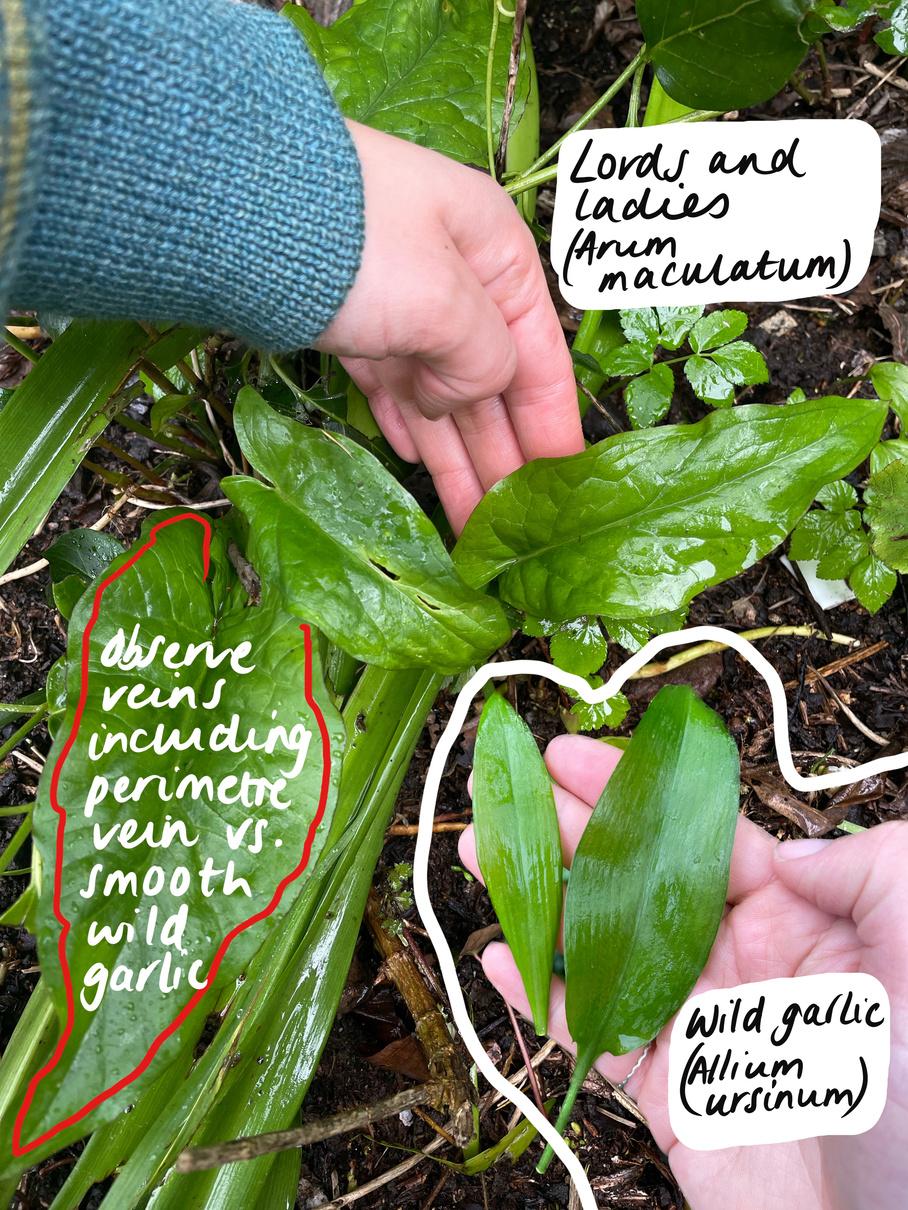
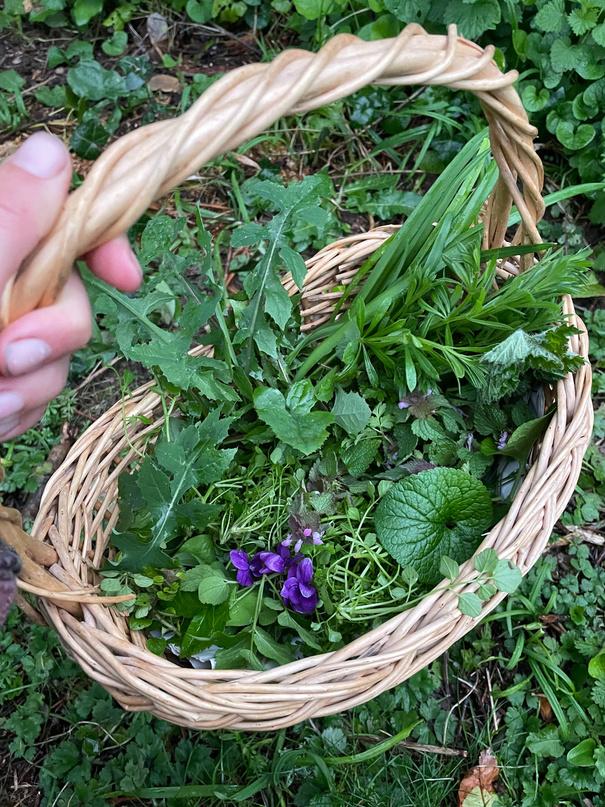
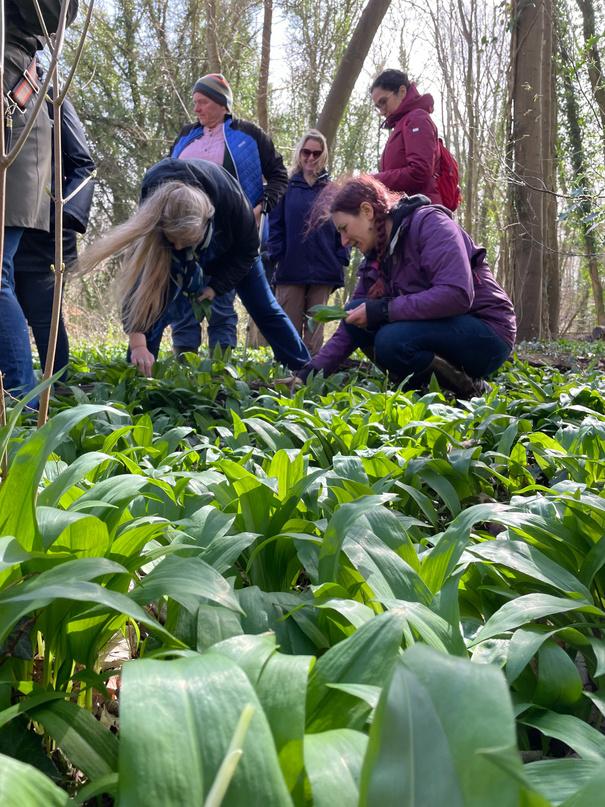

Features 27
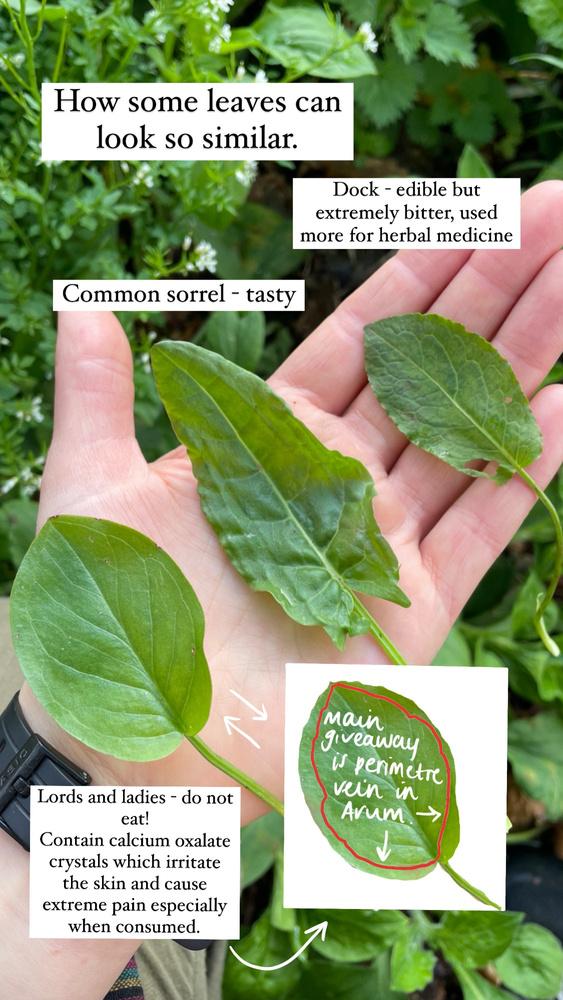
If you are interested in learning more about seasonal eating and foraged foods, you can follow me on Instagram @emanuellepaulson - and if you want to join me for some ‘in person ’ courses, you can find my available foraging courses on my website . I have a few dates coming up in Cornwall in March and April and new dates will be added soon.
A few of my other favourites at this time of year are stinging nettles, common sorrel and magnolia flowers. I love to make nettle soup and pesto, always a good conversation starter too if you make it for friends! Common sorrel is amazing to snack on raw when out walking. It graces our Cornish hedges down here in the south, but grows in pasture and on verges everywhere else. Take care not to confuse it with dock leaves or lords and ladies (see comparison image for tips). Magnolia flowers offer a fragrant and spicy floral hit to salads, or can be stuffed raw with tasty fillings or even used fresh or dried for tea! Different varieties have different flavour profiles, often with ginger or cardamom notes As always please do your own research before consuming any wild plants!
Emanuelle’s list of spring foraging finds
Wild garlic
Three-cornered leek
Hedge garlic
Primroses
Dandelions
Magnolia flowers
Forsythia flowers
Cleavers/goosegrass
Sow thistle leaves
Thistle stems
Violets
Ground elder
Hairy bittercress
Red-dead nettle
Stinging nettles
Pennywort
Oxalis
Common hogweed shoots
Jelly ear fungus
Gorse flowers
St George’s mushroom
Common sorrel
Yarrow
28

600g plain flour
450ml warm water
3/4 tsp instant yeast
2 tsp salt
1 cup of wild garlic butter/pesto
1 Add flour, yeast and salt to a bowl and mix well
2 Pour in the lukewarm water and stir This will be a very sticky dough, just make sure all the flour has been incorporated, but don’t worry about it forming a stiff dough, it won’t really.
3 Leave to rise, either 4-8 hours in a warm area (eg airing cupboard or warm house) or overnight at room temperature. It will nearly double in size and have lots of bubbles.
Wild garlic is an absolute delight to use in the kitchen Used raw or cooked, it can be substituted anywhere you would use regular bulb garlic My favourite ways to use wild garlic are in pesto, soups and for garlic bread You can also preserve it easily by drying, combining with salt, fermenting (my favourite!) and freezing This way you can enjoy it all year round if you choose to do so This year, I experimented with incorporating wild garlic into my bread recipes, either chopped straight into the dough for an easy fix, or in a showier recipe such as the one below Do let me know if you try it!
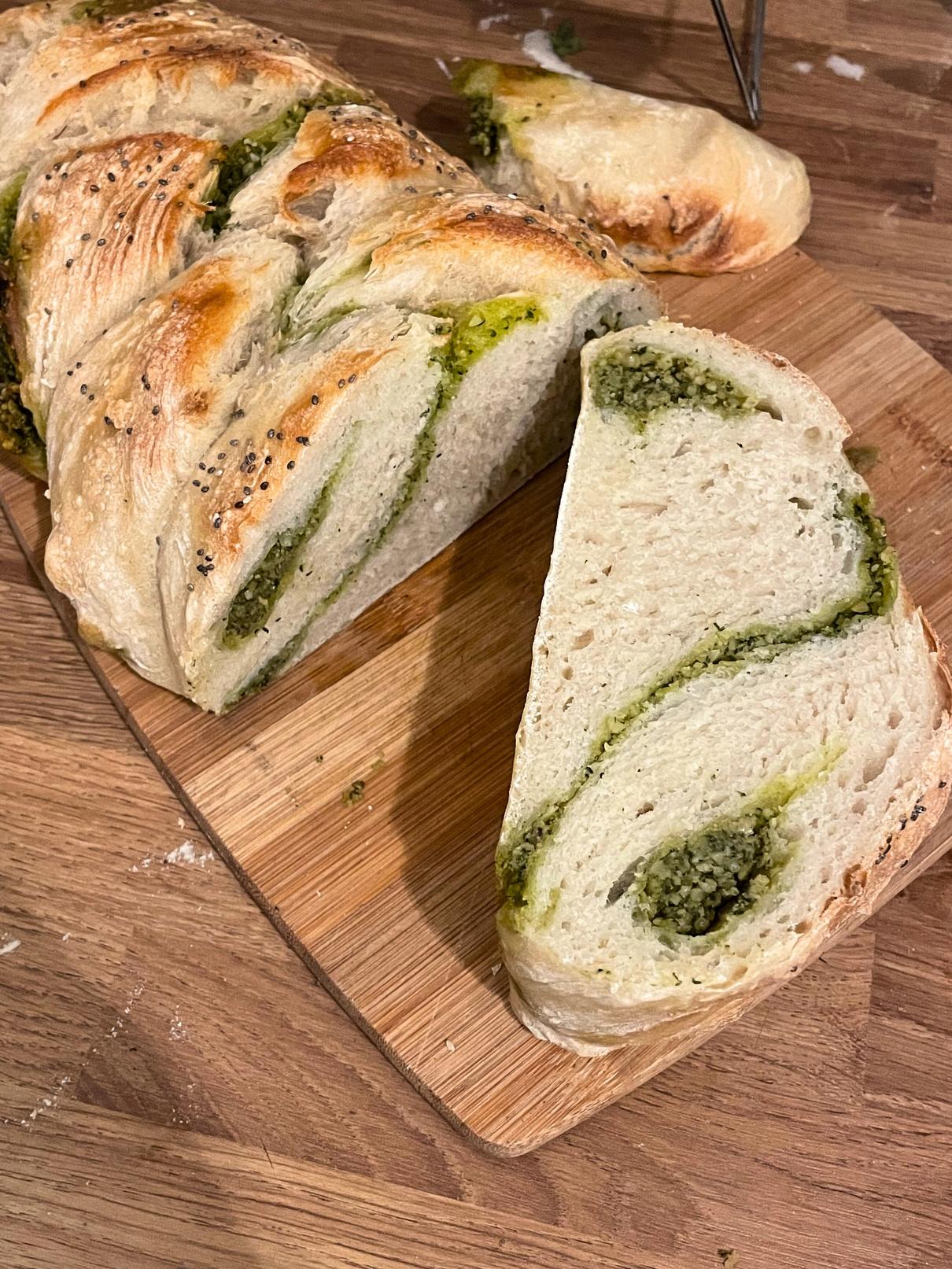
4 In the meantime, make some wild garlic butter or pesto (Pesto recipe below). To make the butter, blend butter with wild garlic and salt to your taste. I added chopped cashews to the butter for texture You can use as much or as little wild garlic as you want, but I find that one or two large handfuls is plenty for one loaf
5 When risen enough, tip the dough onto a heavily floured surface and knead very gently, just enough to form a long loaf/cylinder that will hold its shape
6 Cut into three equal parts and roll into sausage shapes Flatten the sausages with your fingers to form three long, narrow, flat shapes.
7 Using a spoon or small spatula, spread a third of the pesto or butter onto each dough section and fold in on itself to encase the filling completely within the dough
8 Press the ends of the three filled dough sausages together and braid the three strands.
9 Move to a baking sheet or dish lined with parchment paper or non-stick sheet. Allow to rise for a further 30 mins if required.
10 Brush with milk or egg wash and sprinkle with seeds if desired
11 Bake at 180C for 30-35 mins until golden brown on top, and some of the filling has burst through the braid

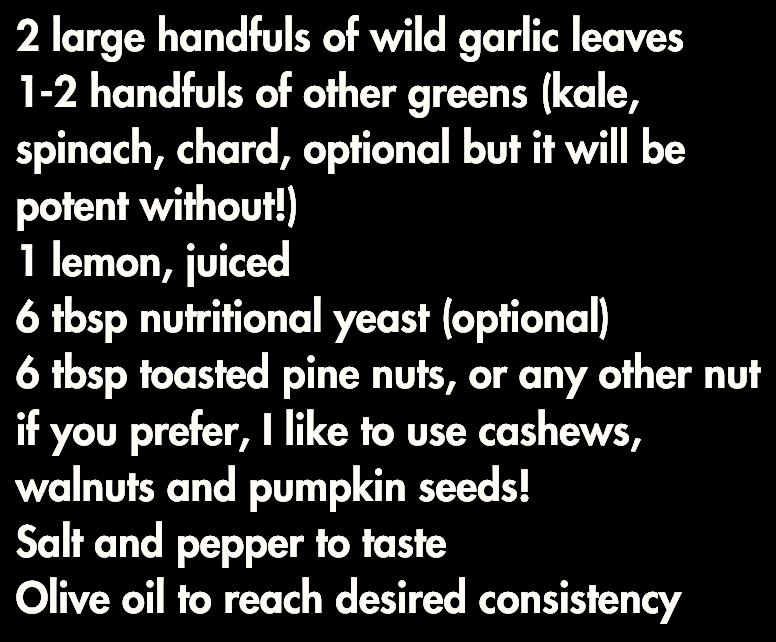
1 Blend all ingredients in food processor or high-speed blender, adding oil to desired consistency
2 Serve immediately or can be stored in the fridge for a while, or in the freezer for a long, long while!
Note: This recipe is very much a ‘to your taste’ thing, add as much or as little wild garlic, salt, pepper, nuts, oil etc as you like Feel free to experiment with different greens, nuts, flavours as you please!
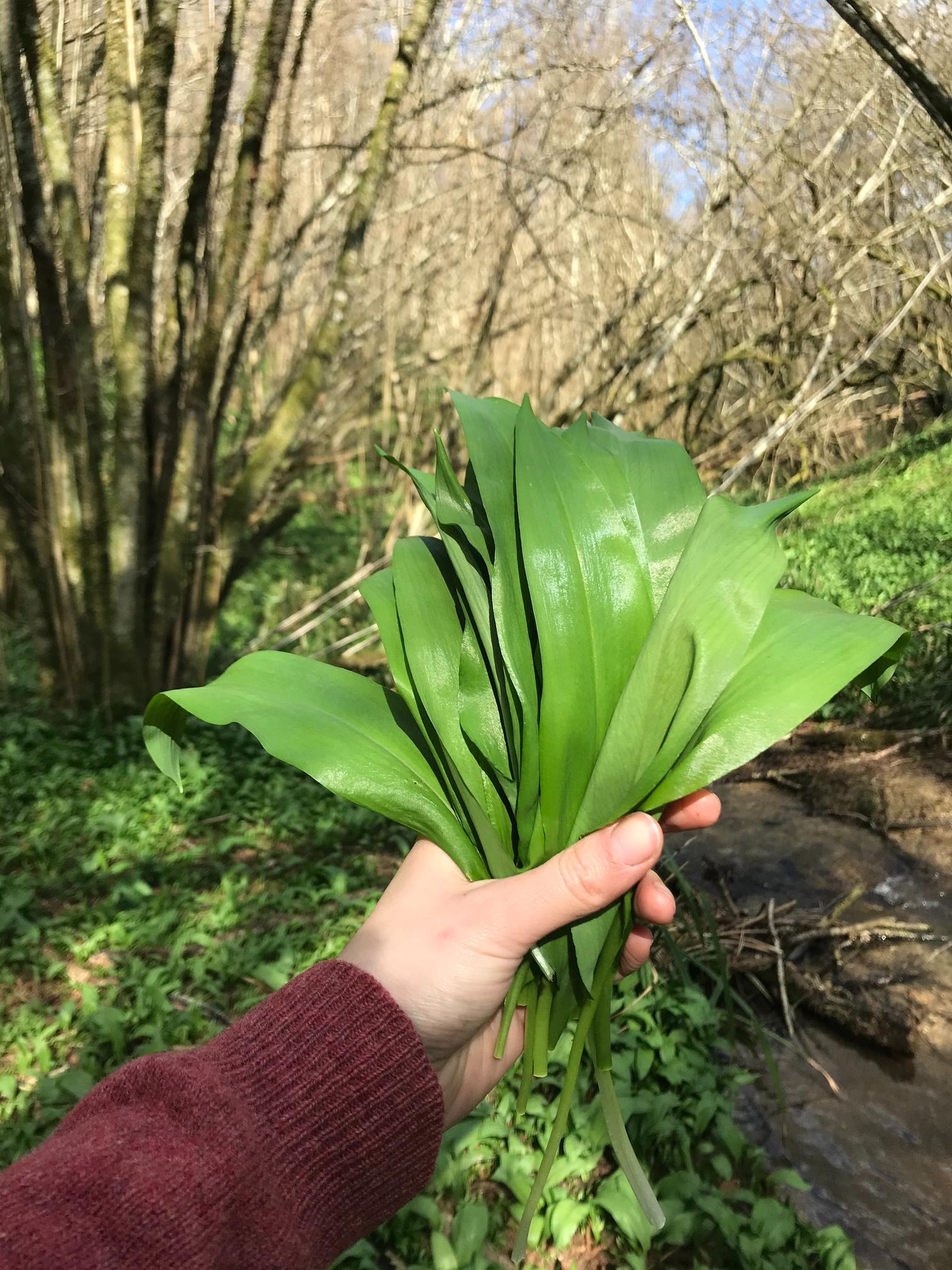



The Creative Kitchen is a book that will appeal to anyone interested in using their homegrown vegetables, eating seasonally or trying to include more plants in their diet Stephanie hopes to inspire you to create seasonal meals and organic products for yourself, family, home and garden
‘The Creative Kitchen is full of economical plant-based recipes for everyone - over 180 recipes! I really wanted the book to be good value, so filled it with as many recipes as I could for meals, drinks and homemade products for your home The book is full of ideas to inspire you to be creative in your kitchen. There is a whole chapter based on the salads I make as a freelance chef, which are complete meals in themselves.’ Stephanie Hafferty
You’ll learn how to create fantastic, flavourful, colourful meals yearround with clear, uncomplicated and delicious recipes. All of the recipes are vegan and the 'potions' also use plant-based oils and waxes. Almost all of the ingredients you will need can be homegrown in your garden or allotment and are also widely available in markets and shops Although they are all ‘from scratch’ recipes, where practical, fresh ingredients such as tomatoes and beans can easily be replaced with tins or frozen veg for speed and simplicity
‘Stephanie’s book is indispensable for any kitchen, but particularly if you grow your own, as she truly understands harvests and gluts and how you might have to think creatively about what the garden imagines supper might be. There’s plenty on storage, teas, cordials and delicious meals year-round from what you can grow at home I promise it will be a well-thumbed addition.’
Alys
Keep an eye on the @gardenfolkmag Instagram page for details of how to enter.
 Stephanie Hafferty is a no-dig organic gardener, writer and consultant. She runs courses at her homestead in West Wales which include Organic Gardening, Homesteading Skills, Preserving Skills and Plot to Plate seasonal recipes
Fowler: Garden writer, horticulturalist, TV presenter, journalist & author
Stephanie Hafferty is a no-dig organic gardener, writer and consultant. She runs courses at her homestead in West Wales which include Organic Gardening, Homesteading Skills, Preserving Skills and Plot to Plate seasonal recipes
Fowler: Garden writer, horticulturalist, TV presenter, journalist & author
31 This month
@stephaniehafferty nodighome.com
P h o t o C r e d i : S e p h a n i e H a f f e r t y P h o t o C r e d t : P e r m a n e n P u b l c a t o n s
“The Creative Kitchen” is published by Permanent Publications
By Jen Howarth @life on the lot



March is always a busy month on the plot. Seeds to sow, beds to get ready, paths to maintain, plans to execute, seedlings to worry over, frosts to dodge… the list can be endless. The trick to getting through this is to deal with the overwhelm.
The overwhelm is totally real! I get it all the time
My way of battling this beast is to break everything down into smaller jobs; little and often I try to make some of these jobs a regular routine; I combine walking the dog with a little spot of watering or I sow a few seeds as the first job on the plot before you get distracted by lots of other little jobs!
Planning your time wisely is always a great move!
Other March plans on the plot are always known as ‘what I can do that isn’t going to get caught in the frost!’ It can be tricky, in the want and need to get things started, but finding the right time to do so Firstly, check your last frost date for your area, this can be much later than you think and plan accordingly
March will see me digging my dahlia tubers out of storage. I tested a new way to store them this winter using cling film – I’m excited to see if this method has been successful! I’ll also be potting them up in the greenhouse to get them started but my horticultural fleece will be handy due to the frosts.
Its also time to get sowing all those fabulous annuals that you have been dreaming of all winter. Snaps, Cosmos, Stocks, Delphinium, Strawflowers – the list is truly exhaustive, and March really is yours for the taking!

Something I’ve never grown from seed before is dahlias, despite growing a huge number of varieties from tubers for many years. It’s a seed I have never tackled!
Together with the Garden Folk gang we are going to sow some seeds and watch the results, learning as we go!
The variety we have chosen to go with is Bishops Children. This is due to it being a pretty good all-rounder for different soil types, a brilliant companion for a vegetable patch and due to it being an open single its brilliant for pollinators
I can’t wait to share this journey with you this year and hopefully produce some fabulous tubers to keep for next season or share with friends!
If you would like to grow along with us get in contact so we can send you some seeds
P h o t o C r e d t : J e n H o w a r h P h o o C r e d i : K i m O ’ B r i e n 32 This Month

The work we can do in the garden really steps up a notch this month as the light levels improve and the temperatures start to warm up We’re here to help you prioritise those tasks and make progress with the ‘to do’ list
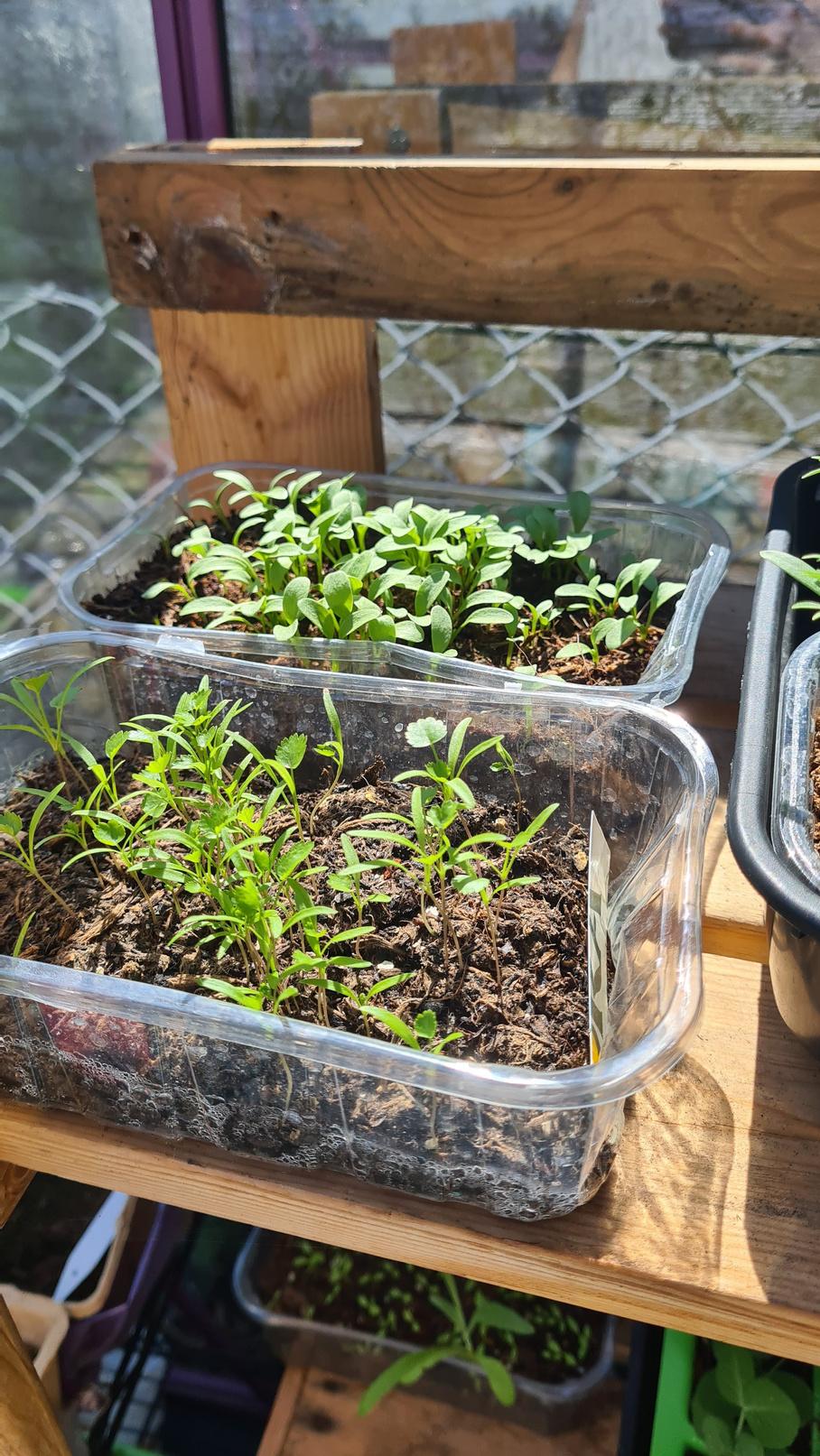
Things to sow
Flowers
Cosmos
Strawflower
Delphinium
Marigold
Sunflower
Rudbeckia
Cornflower
Nasturtium
Dahlia
Edibles
Tomato
Carrot
Chard
Aubergine
Cucumber
Squash
Courgette
Sweetcorn
Come and join the @gardenfolkmag team for live sow alongs throughout the month.

This month we ’ re loving the ‘Through the Garden Gate’ Podcast from Jamie, Ben and Marc Join them to explore the gardens of guests from across the globe

There are so many jobs you can do in the garden and veg patch in March and it’s easy to get overwhelmed But fear not, the Garden Folk team have you covered with this handy check list of timely tasks

Cut down and mulch autumn fruiting raspberries
Put up supports for climbers
Cut back dead foliage on perennials and make way for new growth
Start mowing the lawn
Feel some sun on your face
Prune roses, cornus and willow
Pick a posy of spring flowers
Plant shallot and onion sets
Lift and divide perennials
Deadhead daffodils but let foliage die back naturally to feed the bulbs
Plant first early potatoes
Weed and mulch asparagus beds
33 This month
This month we asked you:
“What are you celebrating in your garden?”
I’m having a go at making my own raised beds @happyplacegardener
My very first tree- Hawthorn Paul Scarlet, perfect for wildlife @aoifes allotment adventure
I am manifesting a garden as will be buying a house in a couple of months, send good vibes!
@martynakrol.greens
I’m celebrating my last year gardening on my plot @theheirloomkg
My very first time forcing rhubarb
@mrs.r garden life
Cleaning a massive amount of brambles and adding lots of space for growing at the plot!
Polytunnel Incoming!
@agardeningmidwife
Spring is just round the corner meaning we will soon start to see all those wond f l l @theveggrow
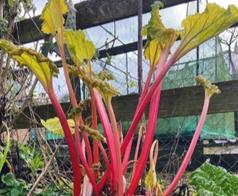
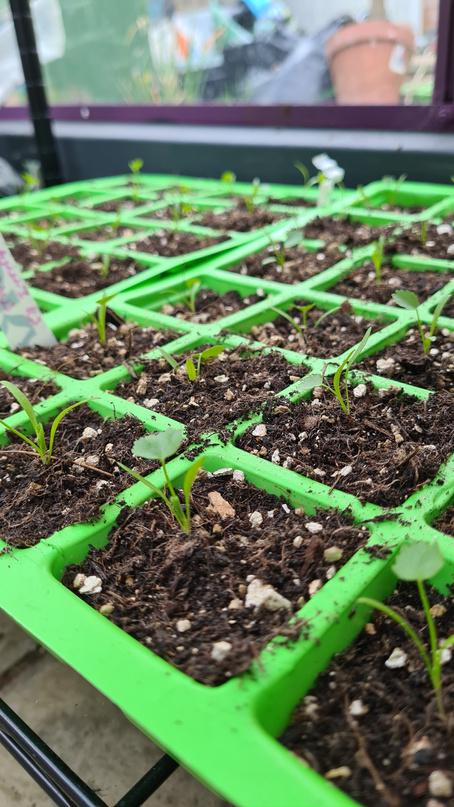

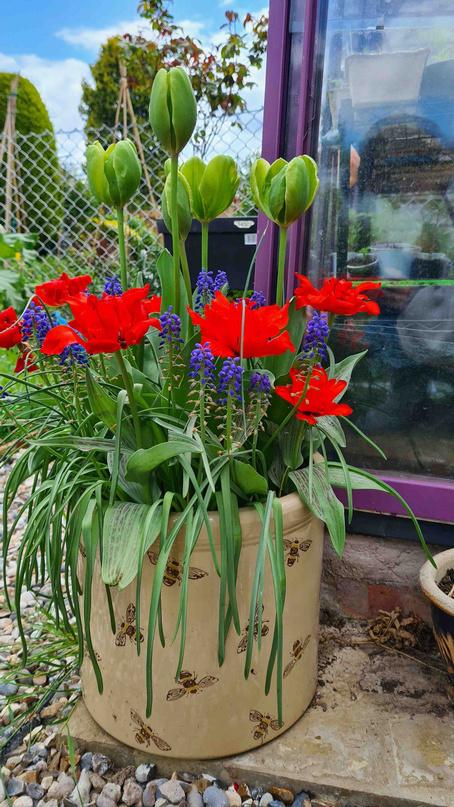
Nearly finished massive log pile the way of my po dreams @kathryn grows stuff
Being nearly ready for spring @life on the lot
My rhubarb, first time forcing it! And my cut flower seedlings, cant wait to start on the veg
@beccafinney13
Lots of negatives in my garden right now, but 1 positive is my living willow structure
@gardeneriddler
The lighter evenings and warly signs of spring are brightening up my days
@fiveminutegardener
Seed sowing flowers for my bbs gw live show garden, chitting potatoes, sowing veggies
@dahliafarmerama
Celebrating successful seed sowing so far, last year had dodgy compost and was awful!
@jensgardenlife
Next month we want to know: “ What is your top tip for growing sustainably?”
Send us a message on Instagram or email us your answers to info@gardenfolkmag.com 34


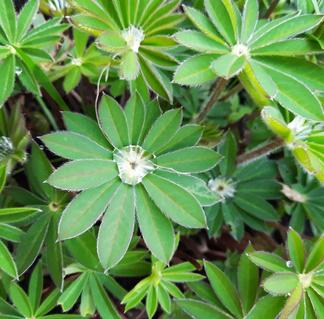

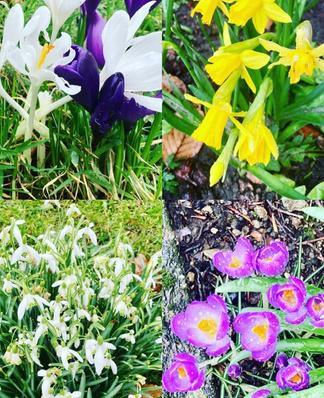



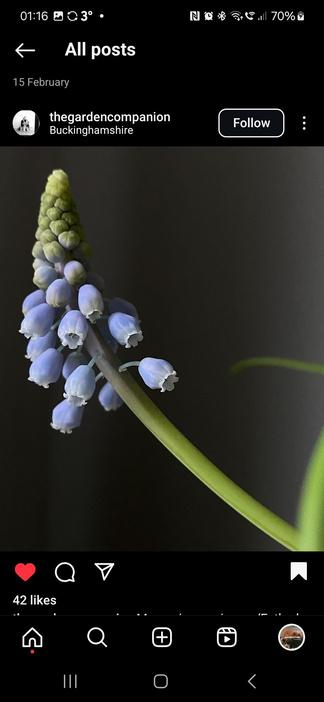
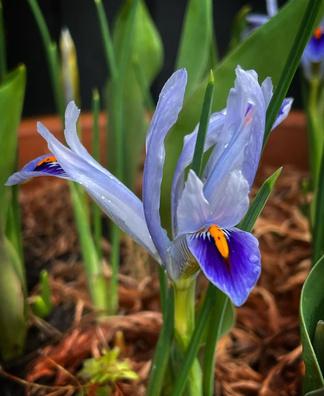
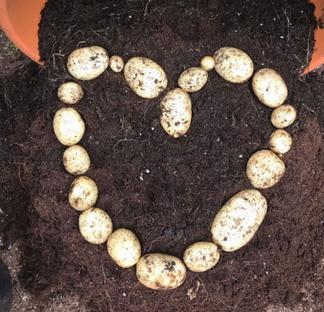
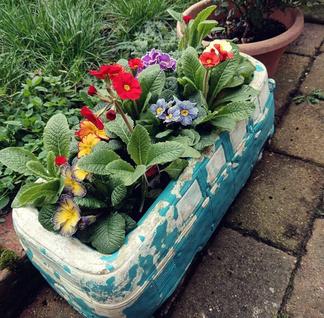
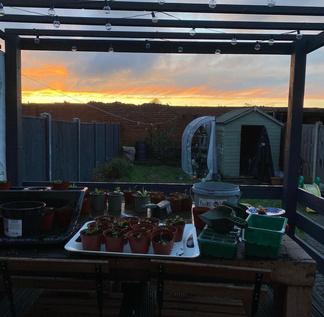

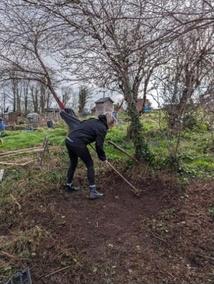
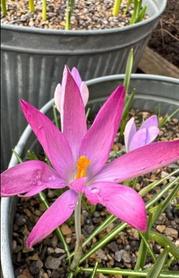





@ s o m e r s e t a l l o t m e n t @ t h e g r e e n w o o d g a r d e n @ j e n s g a r d e n l i f e @ p o d d e r s g a r d e n p o t t e r i n g @ t h e l i t t l e f l o w e r b o x . c o . u k @ r a i n b o w d a y s a l l o t m e n t This month 35
@4mcds bloomingplot
@mynorfolkgardenjourney
@lienagardens
@allotmentescapes @ thequietplace @welliesandwaffles
@she.adores.outdoors
@mamma gs garden @amys allotment adventure
@sarah accidental gardener @thegardencompanion @possibly a potager
The Gardeners Co. CIC is primarily based at Home Farm, Arlington Court
National Trust, North Devon, EX31 4LW
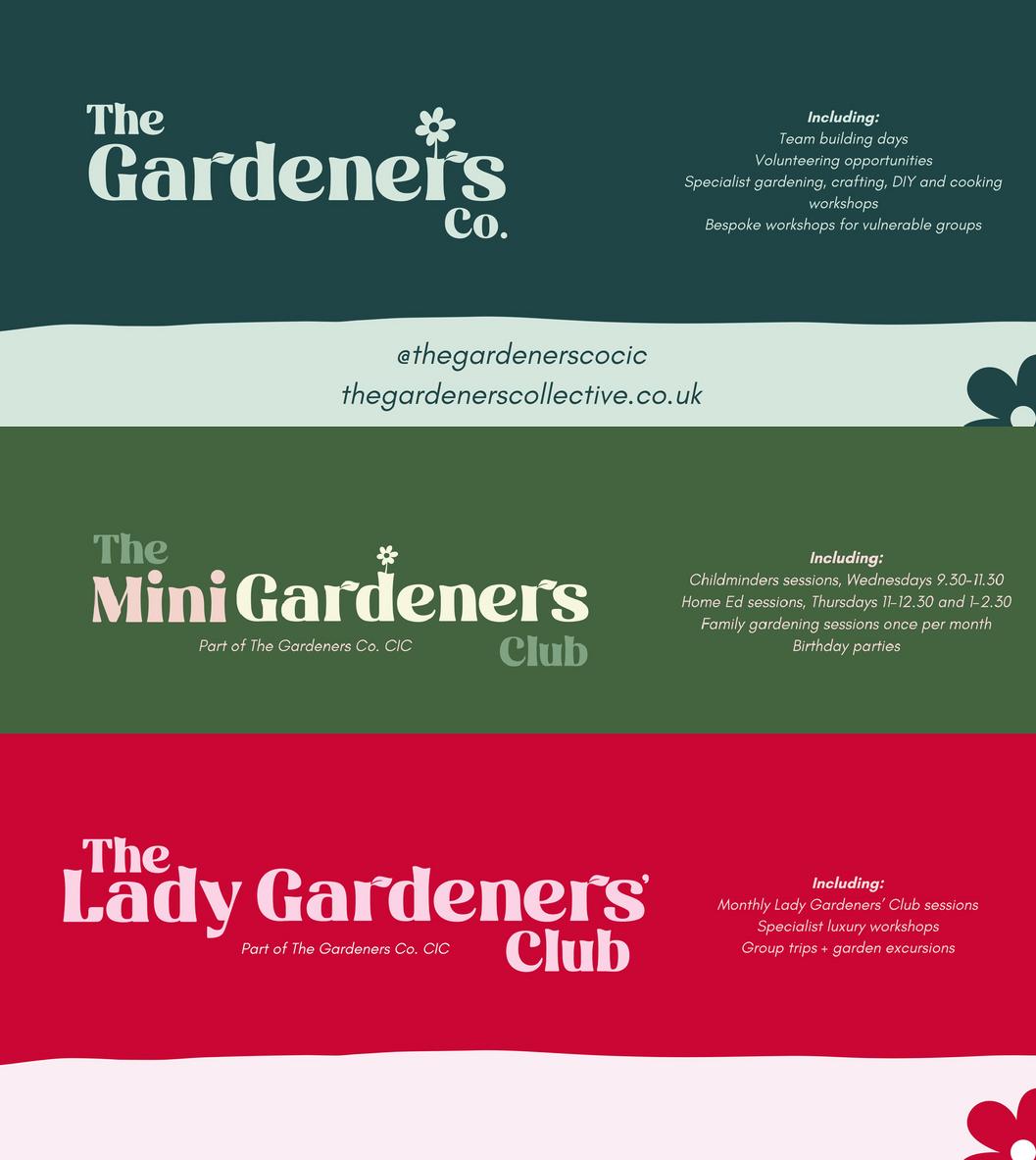
FIND US ON SOCIAL

@THEGARDENERSCOCIC T H E G A R D E N E R S C O L L E C T I V E . C O . U K
Set the date for April 5th for the next issue
Keeping the Community Inspired
I s s u e 1 3 l M a r c h l 2 0 2 4
@gardenfolkmag











































 By Fran Anker @thewild gardener
By Fran Anker @thewild gardener
























































 Stephanie Hafferty is a no-dig organic gardener, writer and consultant. She runs courses at her homestead in West Wales which include Organic Gardening, Homesteading Skills, Preserving Skills and Plot to Plate seasonal recipes
Fowler: Garden writer, horticulturalist, TV presenter, journalist & author
Stephanie Hafferty is a no-dig organic gardener, writer and consultant. She runs courses at her homestead in West Wales which include Organic Gardening, Homesteading Skills, Preserving Skills and Plot to Plate seasonal recipes
Fowler: Garden writer, horticulturalist, TV presenter, journalist & author


































